Thanks to Malcolm J. Watkins for bringing the 1890 Barbados Herald advertisement for Flitterkins to my attention.
Additional acknowledgments are incorporated throughout this article.
In England, many other companies other than John Jaques & Son came out with games to capitalize on the rapidly growing tiddledy-winks market. But they couldn’t call the game Tiddledy-Winks since that was a registered trademark of Joseph Assheton Fincher. Therefore, these companies made up new, often playful and quite memorable names for their tiddlywinks games.
1888 • Spoof (and variants) • published by F. H. Ayres
A substantial competitor to the original Jaques line of Tiddledy-Winks games was called Spoof, produced by Frederick Henry Ayres of 111 Aldersgate Street in London. F. H. Ayres introduced several substantive innovative variations to the basic game including Spoof Golf, Spoof Cricket, Spoof Croquet, Spoof Quoits, Tennis Spoof, Cup Spoof, and Ring Spoof.
In contrast, during its first decade, the J. Jaques & Son company only produced the basic game of Tiddledy-Winks (invented by Fincher) and also Flitterkins (invented by H. C. Wilson and A. C. I. Margary), which was a tiddlywinks game played like tennis. That was the extent of Jaques’ tiddlywinks innovations until after 1900, when Jaques produced several new variations on the game of tiddlywinks.
The original game of Spoof was entered at Stationer’s Hall (in other words, copyrighted) on 6 November 1888, claiming the first date of publication to be on 1 November 1888. Note that this date is exactly one week prior to Fincher’s initial, provisional submission of his patent application! At least two varieties of the main Spoof game are known: one with a yellow background on the cover, and the other with a red and green cover background, as shown below.
Historically, other than for its games of Spoof, Ayres is best known for selling its wooden rocking horses over many years.
Spoof • Advertisements
![[+template:(Tucker Tw ID • [+xmp:title+] — publisher • [+iptc:source+] — title • [+xmp:headline])+]](https://tiddlywinks.org/wp-content/uploads/2022/11/1888-11-13-The-Standard-London-page-7-col-4-0.75-down-item-ad-by-F-H-Ayres-1024x256.jpg)
source • The Standard (London) • 13 November 1888 • page 7 • column 4 • 3/4 down
item • Advertisement by F. H. Ayres
game • mentions Spoof, a tiddlywinks game
note • earliest reference to Spoof known so far
Spoof continued to appear in British newspaper advertisements through at least 1899, and Spoof Golf and Spoof Tennis through 1898.
Spoof • Etymology
Spoof (turf), deception, swindle, sell. Properly a childish kind of game like "tiddlywinks."
- Next day I put all my oof
- On to Gold (sixteen to one),
- And now I hear the cry of spoof,
- The race is o'er, and he's not won.
- —Bird o' Freedom
Spoof has been defined by Sir P. Colquhoun as "an unintelligible shibboleth, invented to indicate an idiotic game—a sell. Exactly as 'the loud laugh proclaims the empty mind,' so, to be an adept in the spoof cult, indicates, as the first qualification for that dubious distinction, softening of the brain." This term owes its origin to the game of spoof, played on a draught. board with counters, which have to ·be whisked on the top of the adversary's own counters by means of a small stick. It has been suggested, however, that spoof is from provincial English spoffle, to busy oneself overmuch about a matter of small consequence, to rage over a trifle, as a 'great cry and little wool,' i.e., a cheat or sell. Hence disappointment, deceit."
Albert Barrere (compiler and editor) • A Dictionary of Slang, Jargon and Cant • Volume II, L–Z • The Ballatyne Press • 1890 • page 285
Spoof • Games
Tucker Tw ID • AYR-02 — AGPI ID • G-34147
title • The New Game of Spoof
advertised as • Ring Spoof
variety • yellow cover
marked • Registered
publisher • Frederick. H. Ayres
photograph by • Rick Tucker
original at • Richard Ballam collection, now at Bodleian Library, Oxford, England UK
licenseable • per Creative Commons CC BY-SA 4.0
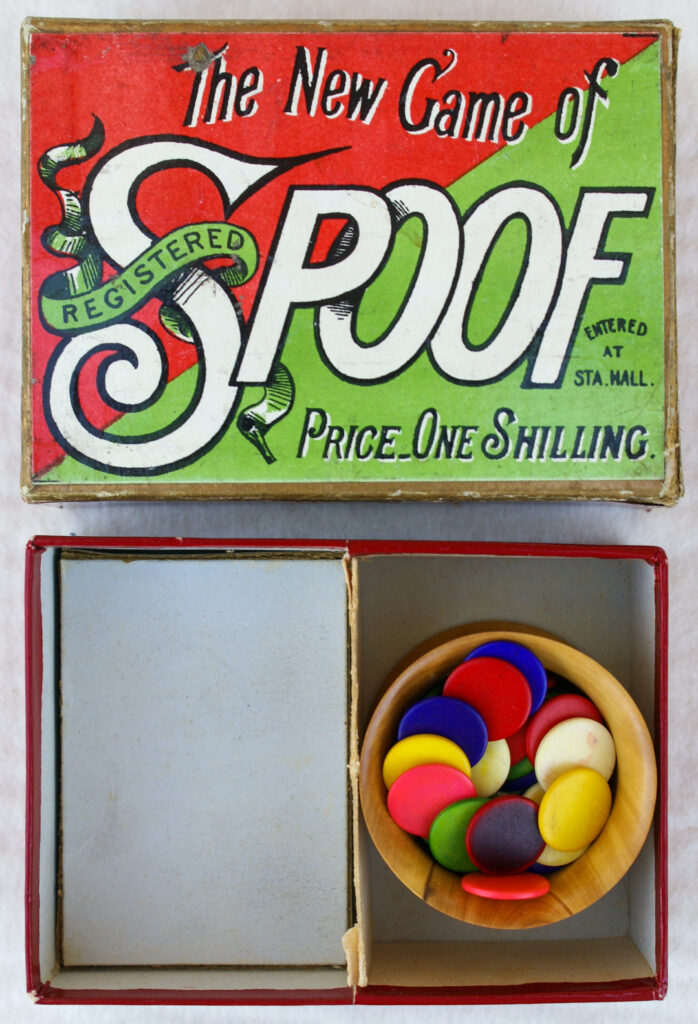
title • The New Game of Spoof
variety • red and green cover
marked • Registered — Entered at Stationers Hall — Price One Shilling
publisher • Frederick H. Ayres
date • 1890s
photograph by • Rick Tucker original at • Tucker Tiddlywinks Collection
licenseable • per Creative Commons CC BY-SA 4.0
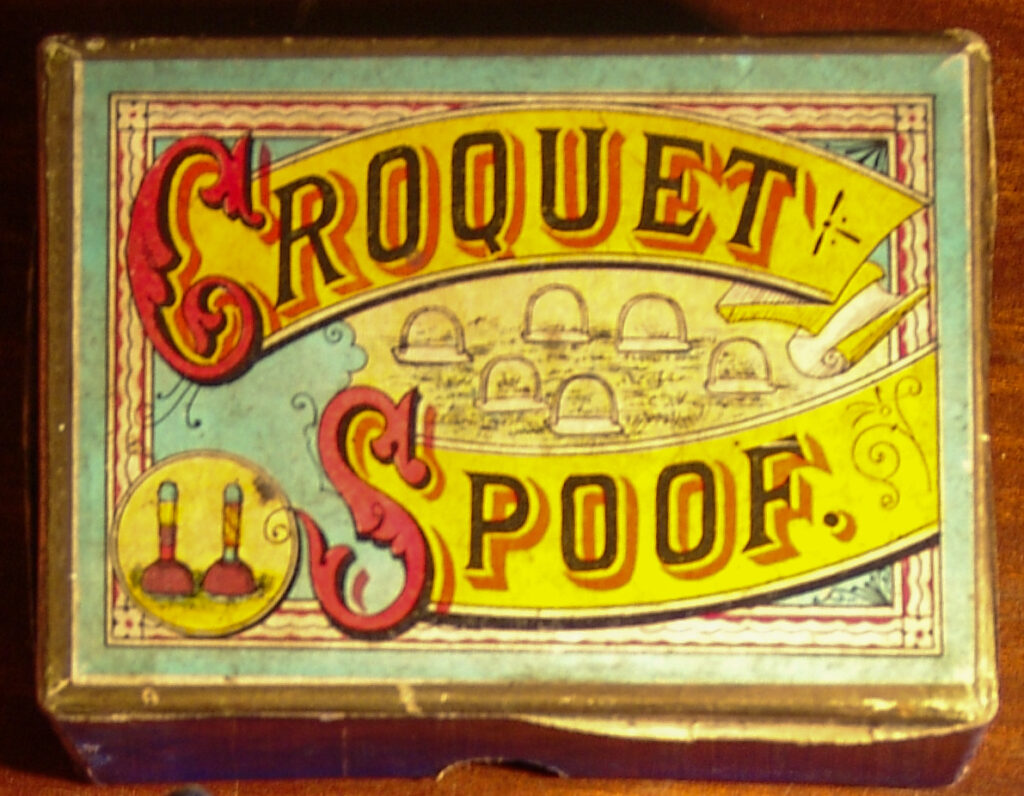
title • Spoof Croquet
publisher • Frederick. H. Ayres
date • 1890s
photograph by • Rick Tucker original at • Richard Ballam collection, now at Bodleian Library, Oxford, England UK
licenseable • per Creative Commons CC BY-SA 4.0
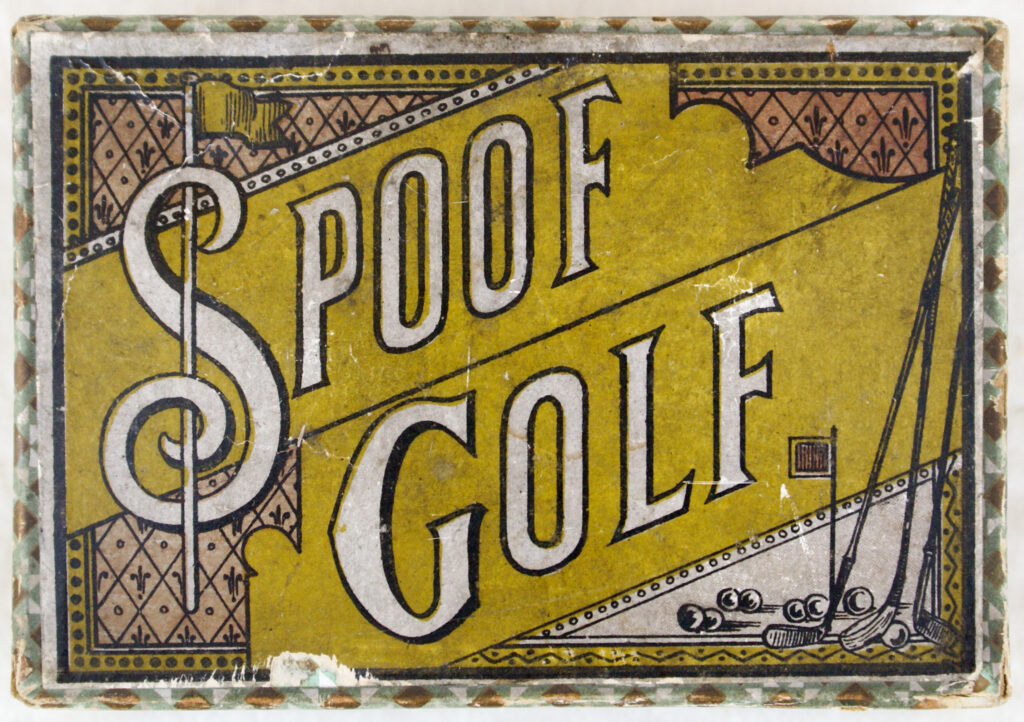
title • Spoof Golf
publisher • Frederick. H. Ayres
date • 1890s
photograph by • Rick Tucker original at • Tucker Tiddlywinks Collection
licenseable • per Creative Commons CC BY-SA 4.0
1888 • Flitterkins • published by John Jaques & Son
Flitterkins was a tennis version of tiddlywinks, patented by H. C. Wilson and A. C. I. Margary and published by John Jaques and Son, who also published Fincher’s Tiddledy-Winks.
Harold Charles Wilson (1860–1940) of Norfolk, England and Alice Constance Inverarity Margary (1863–1943) of Tunbridge Wells, England submitted a patent on 22 December 1888 for A Modification of Lawn Tennis Forming an Indoor Game, which was granted on 16 March 1889 (British patent number GB 1888/18789 A) for a tennis version of tiddlywinks.
Alice Margary was the sister of Anna Daisy Margary, who married Harold Wilson on 3 January 1888. The Margary sisters were daughters to Major General Henry Joshua Margary, Royal Engineers. [sources include: Ancestry.com]
As is the norm for patents, the patent description does not mention the name of the game (Flitterkins in this case).
Notably, this tennis tiddlywinks patent was the first tiddlywinks patent granted in Great Britain and also the world. This patent was granted 7 months before Fincher’s Tiddledy-Winks patent was granted. However, Fincher’s initial application for a patent, with a provisional specification, was submitted a month and a half prior to the Wilson/Margary patent’s initial submission (of a complete specification).
Interestingly enough, the Wilson/Margary patent did not include any drawings, whereas the Fincher patent did.
patent • GB 1888/18789 A
country • Great Britain
patent accepted • 16 March 1889
complete spec • 12 December 1888
claimant • Harold Charles Wilson, Alice Constance Inverarity Margary
title • A Modification of Lawn Tennis Forming an Indoor Game
item • full patent specification
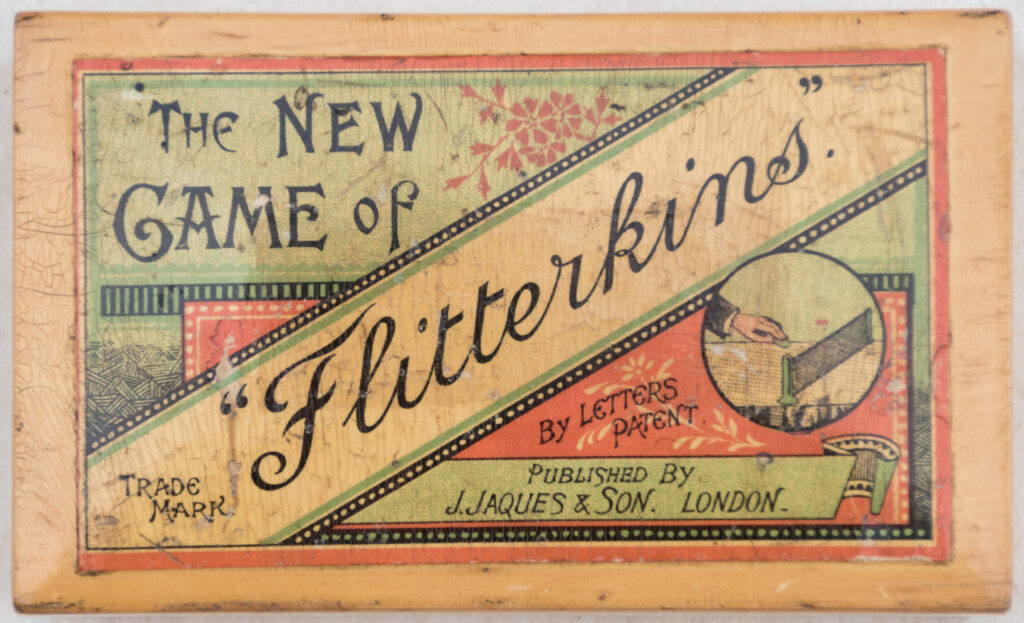
title • The New Game of "Flitterkins"
publisher • John Jaques & Son
marked • By Letters Patent — Trade Mark
variety • wooden Mauchline box
photograph by • Rick Tucker
source: • Tucker Tiddlywinks Collection
licenseable • per Creative Commons CC BY-SA 4.0
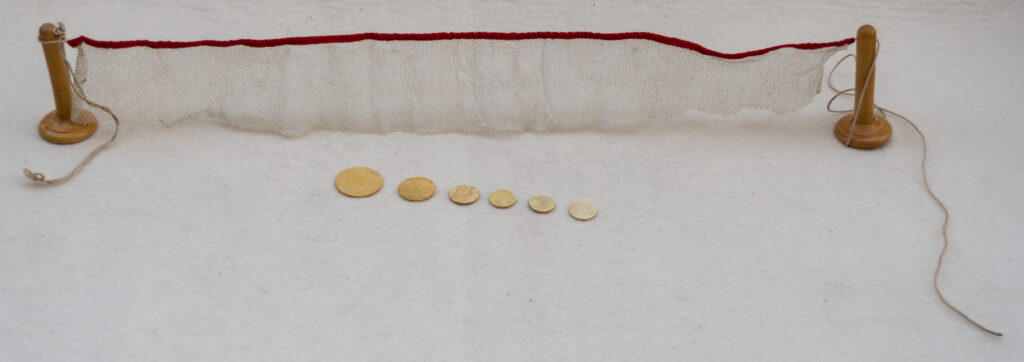
title • The New Game of "Flitterkins"
publisher • John Jaques & Son
item • tennis net and winks
photograph by • Rick Tucker
source: • Tucker Tiddlywinks Collection
licenseable • per Creative Commons CC BY-SA 4.0
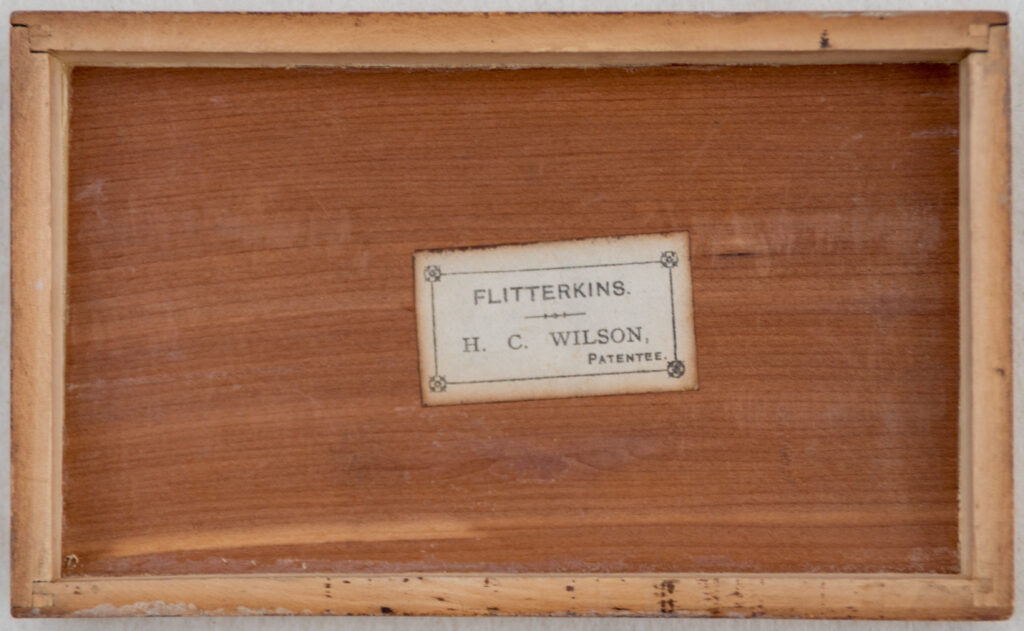
title • The New Game of "Flitterkins"
publisher • John Jaques & Son
variety • wooden Mauchline box
item • label under box lid: FLITTERKINS – H. C. WILSON, PATENTEE
photograph by • Rick Tucker
source: • Tucker Tiddlywinks Collection
licenseable • per Creative Commons CC BY-SA 4.0
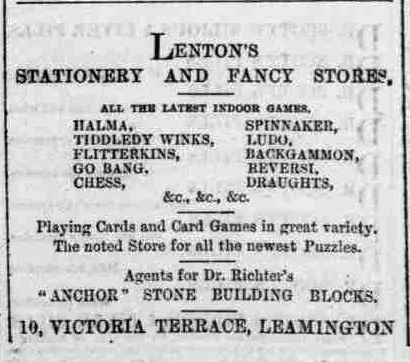
for • both Tiddledy Winks and Flitterkins
date • 12 December 1889
publication • Leamington Spa Courier, page 1, column 5 near bottom
from • British Newspaper Archives
copyright status • public domain
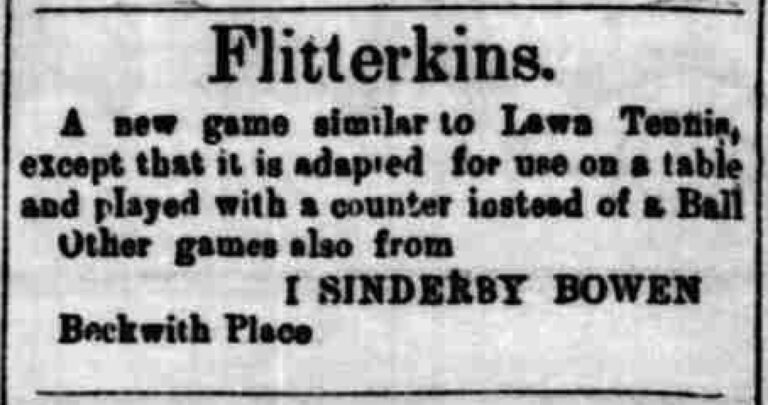
for • Flitterkins
transcript • A new game similar to Lawn Tennis, except that it is adapted for use on a table and played with a counter instead of a Ball
date • 8 December 1890
publication • Barbados Herald, page 2, column 2
from • British Newspaper Archives
copyright status • public domain
1889 • Golfette (or Table Golf) • designed by George Scott
George Scott of Acton, Birkenhead, in the county of Chester in England garnered the third patent in England for a tiddlywinks-style game (# GB 1889/ 09387 A, filed on 6 June 1889 and patented on 22 March 1890), shortly after Joseph Assheton Fincher’s patent. Englishman George Scott also secured the first patent in the United States for the same golf tiddlywinks game, # 431,170, filed on 20 December 1889 and patented on 15 July 1890.
G.B. patent • George Scott
This invention has for its object a new parlour game based upon the well known game of golf. The apparatus consists, 1st. of a course or links formed of felt or other elastic material, preferably about eighteen inches wide, placed round the edge of the table. This felt ean be all cut out of one piece, or can be made of several pieces neatly joined : 2nd. a series of hazards, consisting of imitation streams, stone walls, sheds, turf dykes, and other obstructions placed across the links at intervals to correspond with bunkers, burns, walls, dykes, ponds, roads, whins, rushes, ditches, also sea side and the like : 3rd. in a series of springers or clubs. These have a large variety of ends for different uses, they can be made of wood, bone, or ivory, for the most part, but whether bone or ivory discs are used, one or two of the springers are of metal, preferably steel, as it is found that the use of polished metal is necessary to enable the discs to fly backwards and thus get out from under a hazard. The various forms of springers which I have made in my experimental apparatus are a long sharp point, a dull point formed of two intersecting convex arcs, a convex arc end, a flat end, a sloping side end, also, especially in metal, an end very similar to that of a scratching out knife, such as is often sold by stationers, with varying shaped edges on opposite sides, the edges can be perfectly square, can be sharp, rounded, or bevelled : 4th. In place of balls, I use discs or counters. These discs or counters are preferably of ivory but can be made of other materials. They can be of various shapes and sizes. The size and shape which l prefer, however, is ¾ inch in diameter and about 3/64 inch in thickness. Of this 3/64 inch, 1/64 in the centre of the edge is vertical, but on each side it is bevelled off to about 1/32 inch from the circumference.
G.B. patent 1889/09387 A • by George Scott
patent • GB 1889/09387 A
country • Great Britain
patent accepted • 22 March 1890
complete spec • 6 March 1890
provisional spec • 6 June 1889
claimant • George Scott
title • New or Improved Game and Game Apparatus, Applicable for Use on Parlour Tables
item • drawings submitted with patent application
source • [email protected] (December 2023)
U.S. Patent • George Scott
This invention has been designed with the object of forming a parlor game based upon the rules of the well-known game of golf. Referring to the drawings, Figure 1 is a plan view of a table laid out with the game, showing the various holes, hazards, &c. Fig. 2 is side view of one side of same, illustrating a few of the hazards, &c. Figs. 3, 4, and 5 show various forms of springers. Fig. 6 is a perspective view showing the method of using one of said springers. Referring to the drawings in detail, A is a course of links formed of felt or other elastic material, laid on the surface of the table A' or table-cloth. It is preferably eighteen inches wide and is cut from a long roll. The cuts need not be joined, but can be placed to abut against each other, as shown at a. It can, however, be out cut all in one piece where cost is immaterial. The blank space A' in the center of the course may be utilized for the reception of the various spare springers E F G H I, and for the spare disks J, with which the game is played.
U.S. patent 432,170 • by George Scott
In addition, George Scott first published the rules for Golfette • Disc or Table Golf on 6 June 1889 and applied for a copyright for those rules in England on the same date.
![[+template:(Tucker Tw ID • [+xmp:title+] — publisher • [+iptc:source+] — title • [+xmp:headline])+]](https://tiddlywinks.org/wp-content/uploads/2022/11/Golfette-or-Table-Golf-_-2010-01-05-National-Archives-Kew-_-1889-06-08-copyright-by-George-Scott-title-Golfette-or-Table-Golf-item-ledger-entry-side-right-DSC00279-scaled.jpg)
title • Golfette Disc or Table Golf
copyright claimant • George Scott
item • ledger page, right side
column 1 • Name of Publisher and Place of Publication
column 2 • Name and Place of Abode of the Proprietor of the Copyright
column 3 • Date of First Publication
photograph by • Rick Tucker
original source • National Archives, Kew, England UK
![[+template:(Tucker Tw ID • [+xmp:title+] — publisher • [+iptc:source+] — title • [+xmp:headline])+]](https://tiddlywinks.org/wp-content/uploads/2022/11/Golfette-or-Table-Golf-_-2010-01-08a-National-Archives-Kew-_-1889-06-08-copyright-by-George-Scott-title-Golfette-or-Table-Golf-item-signed-copyright-form-DSC00543-scaled.jpg)
title • Golfette Disc or Table Golf
copyright claimant • George Scott
item • signed copyright application form
photograph by • Rick Tucker
original source • National Archives, Kew, England UK
A man by the name of George Scott won the claret jug in a golf match on 6 June 1881 at the Royal Liverpool Golf Cub, around 8 miles from Acton, and in subsequent matches. However, it has not yet been verified whether this is the same George Scott who patented a golf tiddlywinks game in England and in the U.S.
title • GOLFETTE — by • George Scott
date • 10 August 1889 (per library stamp: University Library, Cambridge)
item • all 12 printed sides of the rules (an additional 2 sides are blank)
publisher • “Chronicle Office”, 4, Victoria Road (now Borough Road), Seacombe, England
copyright marking • Registered at Stationers’ Hall
note • copyright deposit
original at • Reproduced by kind permission of the Syndics of Cambridge University Library
A variant version of this game by George Scott is called as Golfiards—a title suggesting a blend of golf and billiards, though it is not. The University of Cambridge’s Rare Books library has the only copy of the 8 page rules for Golfiards: a new game of skill for the parlor table that is listed on WorldCat, which contains library catalog information from thousands of libraries worldwide.. The following review of Golfiards appeared in the British trade journal, The Field, on 1 November 1890. This review identifies the inventor as “Mr. G. Scott of Oxton, Birkenhead”.
PASTIMES.
GOLFIARDS.
WHEN AN OUTDOOR GAME LIKE GOLF becomes popular, it almost follows as a matter of course that some ingenious person will produce a miniature game of similar character, which can be played indoors. The latest outcome in this direction is "Golfiards."
Given the links, and the drum containing golfiards supplies all else necessary. The links are the dining room table of the period. On this are to be laid strips of green felt, with holes punched at various distances; on the felt are to to placed the hazards at the discretion of the players, who can arrange them so as to be easy or difficult according to their proficiency in the game. The course is now ready. The round is only of six holes, and beginners this round will be found to take enough time to make an amusing game; those who are more skilful, or who wish to prolong the game, can convert the six hole into a twelve or eighteen hole course by making two or three circuits.
Drivers, lofters, niblicks and putters are provided. The balls are replaced by carefully turned discs of ivory. The disc being teed, the driver, properly used, will carry it over the first hazard and land it not far from the first hole. The "like" having been played, the putter may now be brought into requisition. The effect of this implement is to cause the disc to slide along the felt, towards or into the hole.
Suppose the first heard is not cleared by the drive off, and that the disc remains near it. The lofter will cause the disc to jump over that hazard. Care must however be taken in using this instrument, as the disc, after being lofted, is apt to drop on its edge, and to roll off the course. In that ease it most he replaced whence it was sprung, the penalty being loss of the distance. In order to guard against violent and random shots, the penalty for sending the disc off the course without first alighting on it is loss of a stroke and the distance.
And now support a very unfortunate drive off, with the disc in such a position in or near a hazard that the lofter or driver is useless. The niblick will then extract it; the peculiarity of this club is that it sends the disc in a direction contrary to the one in which it would appear to be going. Thus, to fetch the disc out of a hazard, the niblick must be played on the disc in a direction towards the hazard.
The niblicks, putters, and other appurtenances not in use, are kept in the middle of the table, off the course, where they can be easily reached when wanted.
The hazards not being fixed have a way of tumbling over sometimes when a disc touching or in them is played with a niblick. As it is important that they should not be disturbed when once arranged, we suggested, as an addition to the rules, that it should be allowable for the player to steady the hazard with his hand, when the stroke is likely to alter its situation.
If it is desired to make the game more difficult, boxwood cups may be placed over the holes. When these are employed, it is necessary to jump the disc into the cup by means of the lofter, instead of putting it. We confess we are not impressed with these cups. They are foreign to the game, and so far as we have seen at present, holeing in a cup is rather a flaky operation. This may, of course, be due to our want of dexterity. Anyhow the cups are optional, or they may be placed over alternate holes, or only over the last hole. But, in our view, if the game is found too easy without the cups, it is better to increase the number of hazards, by placing pieces of cardboard on various parts of the course, and calling them "water." A disc played on water is to be lifted, and placed behind the hazard, the penalty being one stroke.
The game requires nicety of touch and delicacy of manipulation, varying with the distance of the drive, and the angle of elevation; the quick or slow action, and the amount of pressure needed when playing for certain strokes are matters of practice. Those who have what horsemen call "hands" can learn to play a strong game in a short time; those not gifted with "hands" must be content to remain weak players, and to be handicapped. We do not agree with the inventor (Mr G. Scott, of Oxton, Birkenhead), that golf players will at once find themselves at home with golfiards. The stroke is so different from one with a club, that we are inclined to think a previous knowledge of golf would be at first valueless, except in the matters of rules and scoring. We do not deny that a good player at one game will generally hit off another game more really than a player who does not excel at any; but there the being at home of the golfer at golfiards, in our opinion, ends.
The Field, the Country Gentleman's Newspaper • issue 1,975 • 1 November 1890 • pages 668–669
The rules for Golfiards include illustrations for four different types of squidgers, called Springers: a Driver, Lofter, Niblick, and Putter. Also, the rules align Golfiards to the sport of golf and not at all to billiards.
title • GOLFIARDS A NEW Game of Skill FOR THE PARLOUR TABLE — by • George Scott (not marked)
item • rules
page sides • 8
date • 17 March 1890 (per library stamp: University Library, Cambridge)
publisher • “Chronicle Office”, 4, Victoria Road (now Borough Road), Seacombe, England
patent marking • Protected under the Patents Act, 1883
copyright marking • Registered 1889
note • copyright deposit
original at • Reproduced by kind permission of the Syndics of Cambridge University Library
≥ 1890 • Compendium of Popular Games Played with Counters • published by J. Jaques & Son
According to an advertisement in Jaques’ Table Golf tiddlywinks game, Jaques produced three versions of the Compendium of Popular Games Played with Counters, with one priced at 2 shillings 6 pence, another at 5 shillings, and the best at 7 shillings 6 pence. It is assumed that the most expensive version of this game is the one that came in a wooden box.
The cover of the wooden-boxed editiom depicts 7 different game covers, though only the TIDDLEDY WINKS, “Flitterkins”, and Table Golf titles are fully discernible on the compendium game cover; all three of these are known to be tiddlywinks-style games. Another game cover on the compendium game cover shows “RACE” in its title and is a ring (quoits) game.
The covers of both TIDDLEDY WINKS and “Flitterkins” that are replicated on the cover of this compendium game both note that they are “BY LETTERS PATENT” and are trademarked, and therefore, this game was published no earlier than 1890, the year of both trademark approvals.
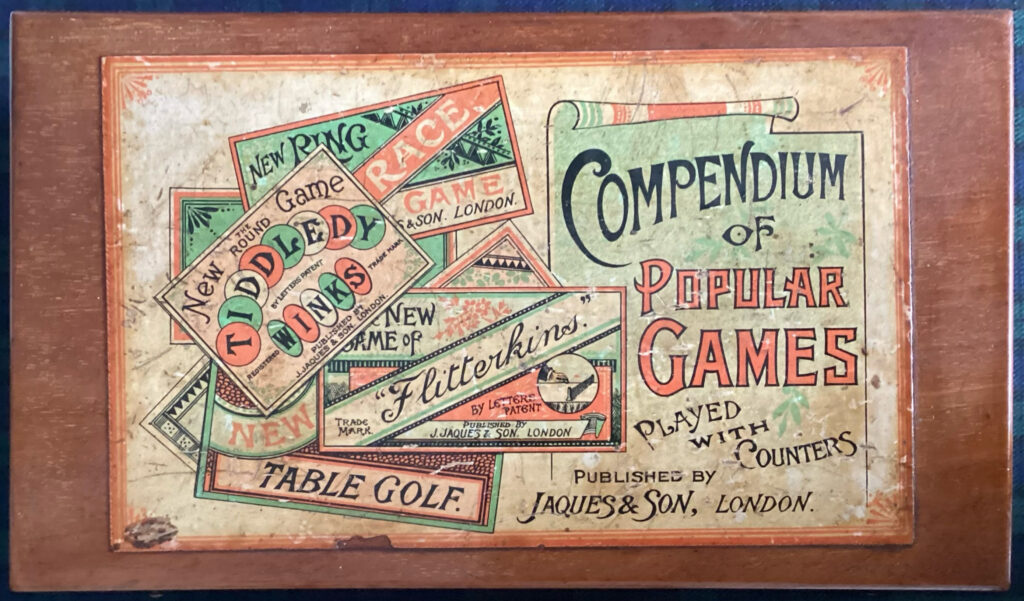
title • Compendium of Popular Games Played with Counters
publisher • Jaques & Son
marked • By Letters Patent, Registered Trade Mark
item • cover
source • Bryce Neilson
licenseable • per Creative Commons CC BY-SA 4.0
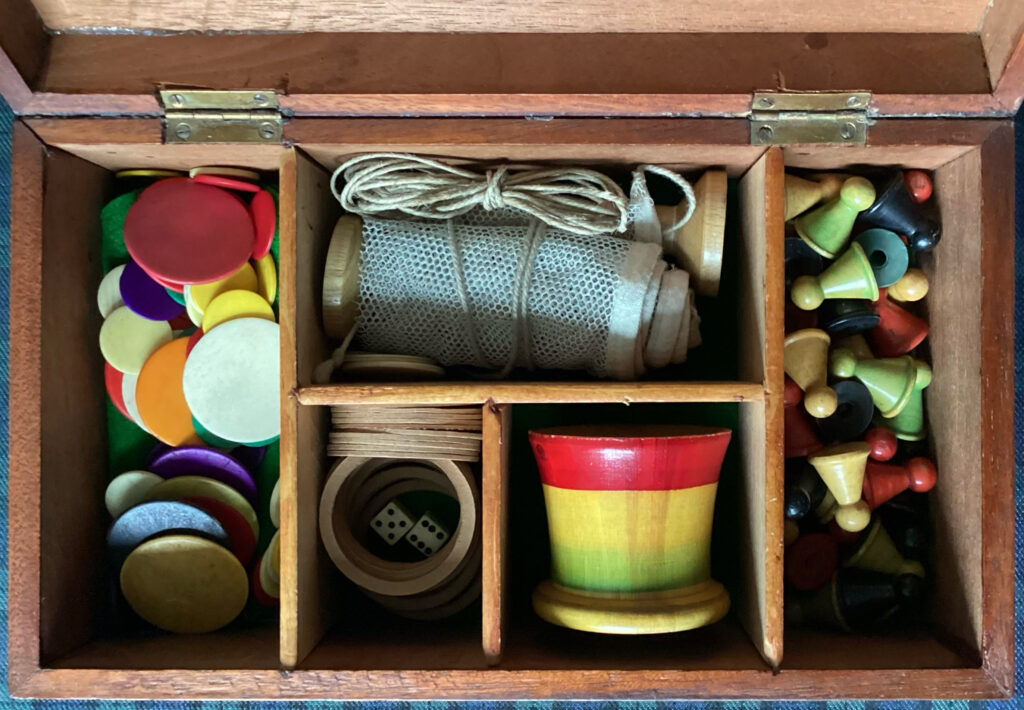
title • Compendium of Popular Games Played with Counters
publisher • Jaques & Son
marked • By Letters Patent, Registered Trade Mark
item • contents
source • Bryce Neilson
licenseable • per Creative Commons CC BY-SA 4.0
≤ 1891 • Pagodah • published by Multum In Parvo
The Multum in Parvo Co., abbreviated M.I.P. Co., in London, produced The Novel Game of Pagodah during or before 1891. This game included a two-tier wooden pot target, which was an innovation for its time.
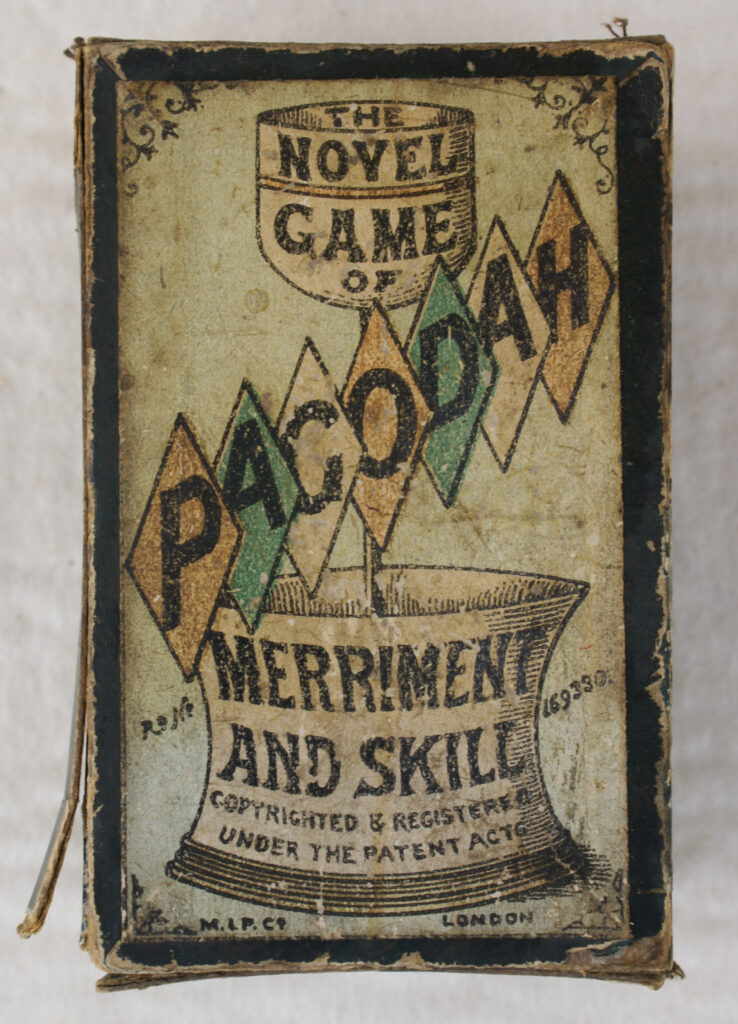
title • The Novel Game of Pagodah
publisher • Multum in Parvo Co.
marked • Copyrighted & Registered — Registration # 169330
item • cover
photograph by • Rick Tucker
original at • Tucker Tiddlywinks Collection
licenseable • per Creative Commons CC BY-SA 4.0
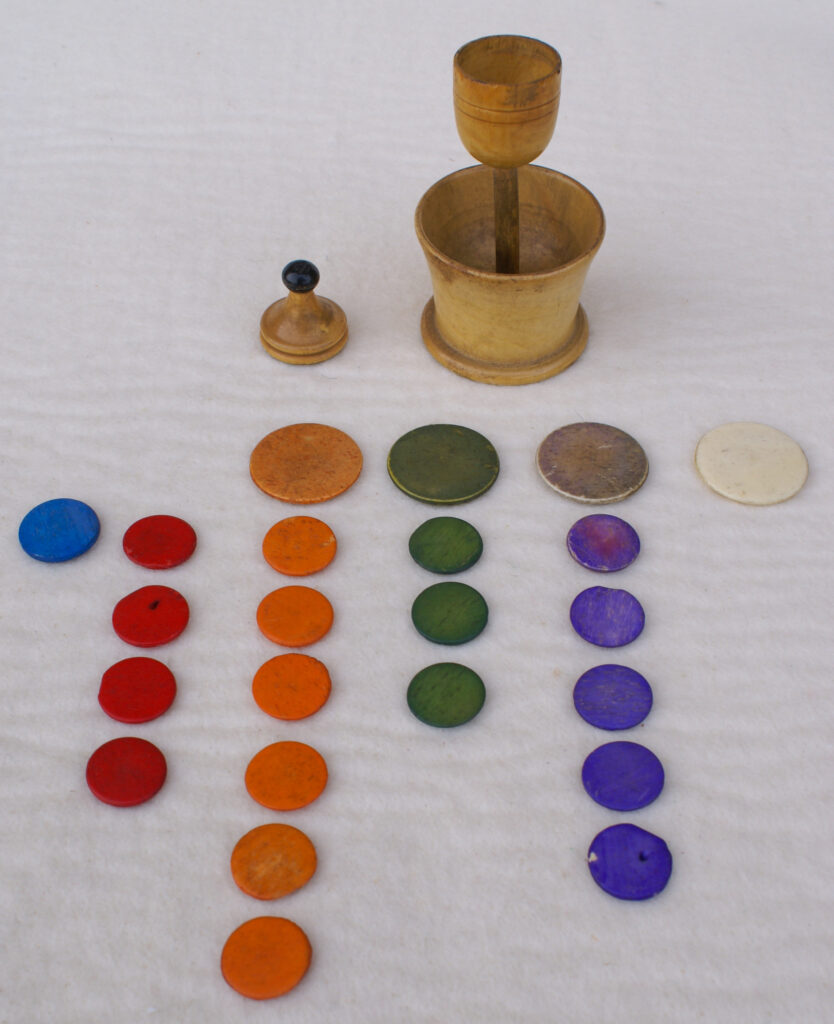
title • Pagodah
publisher • Multum in Parvo Co.
item • two-tiered cup, squidgers, and winks
photograph by • Rick Tucker
original at • Tucker Tiddlywinks Collection
licenseable • per Creative Commons CC BY-SA 4.0
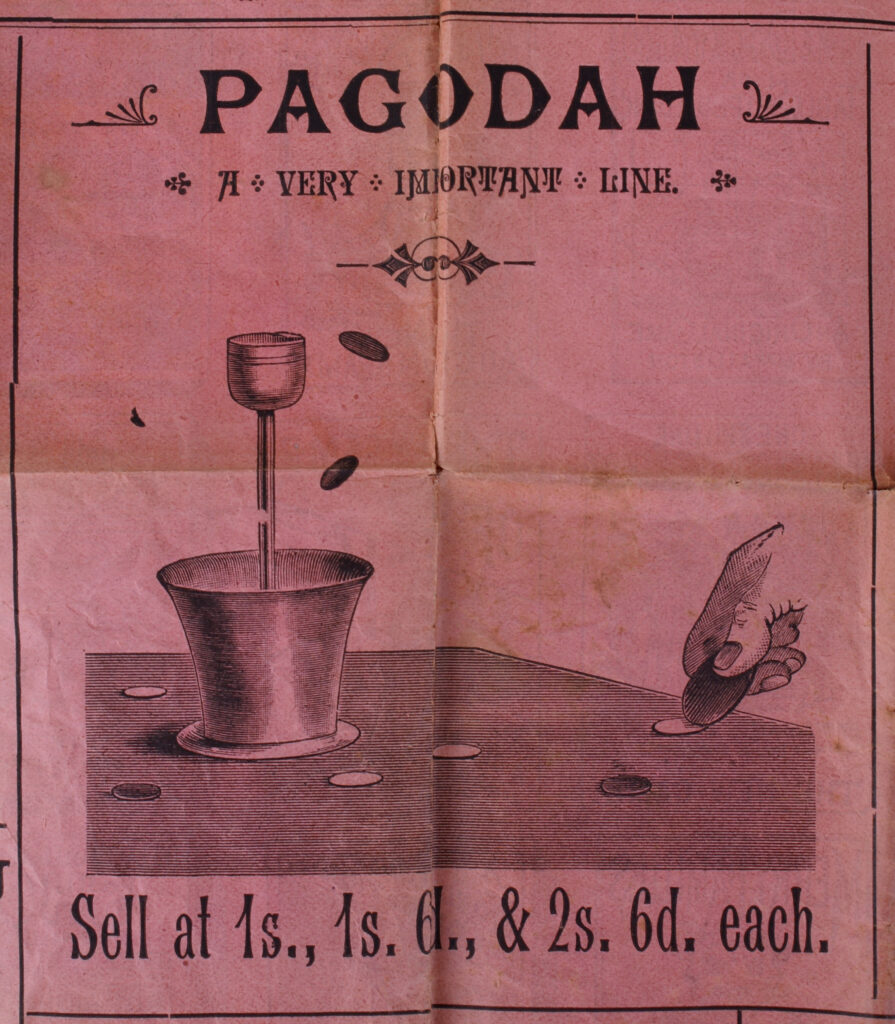
title • Pagodah
publisher • Multum in Parvo Co.
item • advertisement for Pagodah, for 3 differently priced editions, inside a Pagodah game
photograph by • Rick Tucker
original at • Tucker Tiddlywinks Collection
licenseable • per Creative Commons CC BY-SA 4.0
≤ 1891 • Flipperty Flop • branded as Globe Series • published by Emil Oppenheimer & Ignaz Sulzbacher
The game of Flipperty Flop was published under the brand of Globe Series in England that was manufactured in Germany by Emil Oppenheimer and Ignaz Sulzbacher. Note that Sulzbacher garnered a British patent for a separate tiddlywinks game, Sweet Wedding Bells, where winks are shot to ring a bell in a bell tower.
Two varieties of Flipperty Flop have been sighted: one with a wooden box with a sliding wooden lid, and another in a cardboard box. “Registered” appears below the title in red on the wooden box edition but not on the cardboard box edition.
The earliest known mention of Flipperty Flop is in an 18 September 1891 advertisement by The “Observer” Stationery Warehouse in the Wigan Observer and District Advertiser (page 7, column 1), which lists several tiddlywinks games — Flipperty Flop, Tiddleywinks, Crickets on the Hearth, and Pagodah.
![[+template:(Tucker Tw ID • [+xmp:title+] — publisher • [+iptc:source+] — title • [+xmp:headline])+]](https://tiddlywinks.org/wp-content/uploads/2022/10/1891-09-18-Wigan-Observer-and-District-Advertiser-page-7-column-1-599x1024.jpg)
Another mention of Flipperty Flop appears in a 29 September 1891 advertisement by retailer John Heywood in the Manchester Courier in England (page 1, column 7). The advertisement also lists Tiddle de Winks (a likely misspelling) and Spoof, other tiddlywinks games from that time.

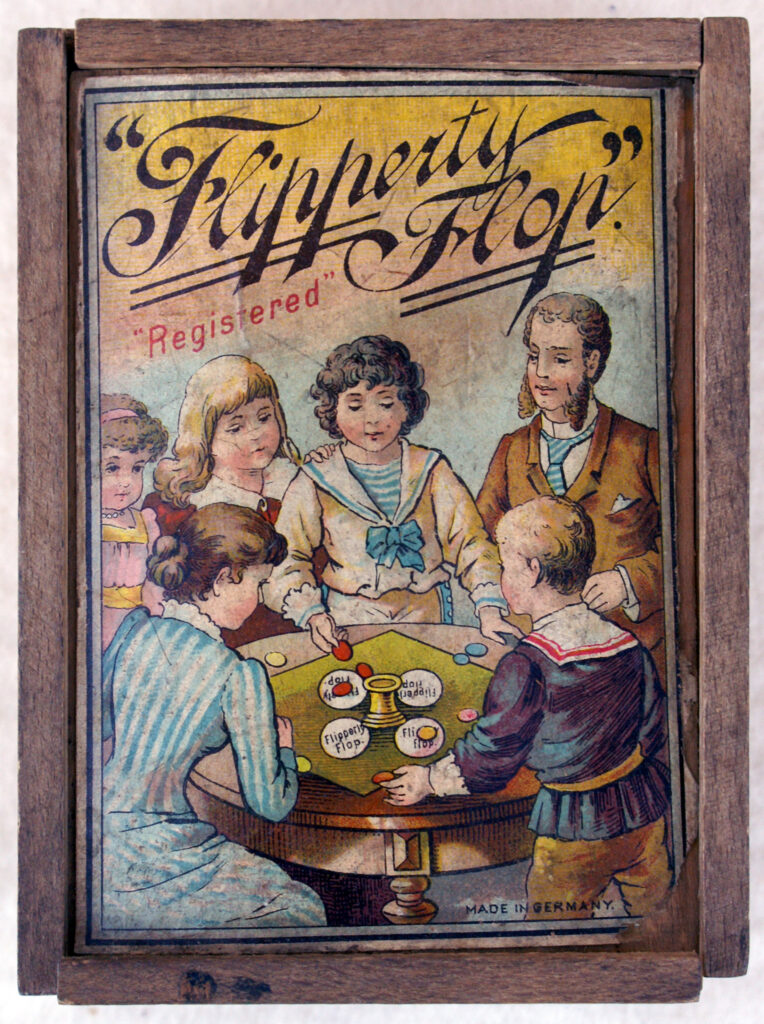
title • Flipperty Flop
publisher • Globe Series
marked • Registered
item • game cover
variety • wooden box with sliding cover
photograph by • Rick Tucker
source • Tucker Tiddlywinks Collection
licenseable • per Creative Commons CC BY-SA 4.0
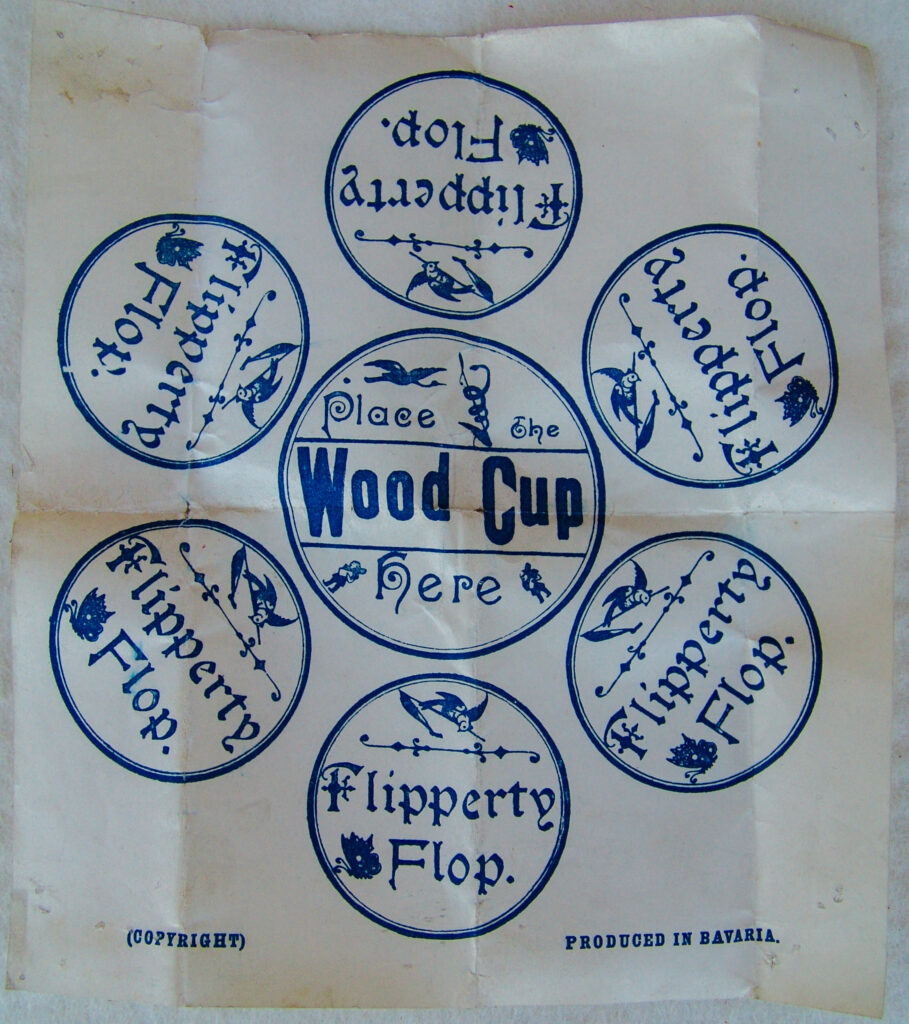
title • Flipperty Flop
publisher • Globe Series
marked • Registered
item • paper target
variety • wooden box with sliding cover
photograph by • Rick Tucker
source • Tucker Tiddlywinks Collection
licenseable • per Creative Commons CC BY-SA 4.0
While perhaps unrelated to the naming of the Flipperty-Flop game, The Flippity-Flop Young Man, written by Harry Adams, was a popular song in the early 1880s.
The Flippity-Flop Young Man.
I ONCE was a matter of fact young man,
And thrived on port and sherry ;
But now I'm a kind of a cracked young man,
The reverse of or-din-ary.
I flip and I flop {echo)
All over the shop (echo)
And take it for granted you can ;
I'm a very Sunflowery, Aprily showery,
Eastcheapy, Towery man.
Chorus —
I'm a very aesthetic young man,
A non energetic young man,
Slippity sloppity over the shoppity,
Flippity flop young man.
I once was a hymny and tract young man,
And sternly opposed to stooping ;
A kind of a stick up the back young man,
But now I incline to drooping,
Consummately if (echo)
On no account stiff (echo)
I scarcely know how I began ;
I'm a bitter and mildy, naturey childy,
Oscary Wylde-y man.
Chorus —
I'm a Fuller's earth colour young man,
A greeny and " yuller " young man :
Pretty externally " Patience " and " Colonelly, '
Utterly, utter young man.
I once was a cobby and hack young man.
And a little bit calico bally,
A picture card out of the pack young man,
And frequently Music Hally.
I'd sing and I'd shout (echo)
"Poor 'Liza" about {echo)
And after the ladies I ran,
Said Jenny to Amily, Oh, he's a jammily,
" Morally, family man."
Chorus —
But I'm now a good goody young man,
A head rather " Woody " young man :
Body quite rickety, pose plas-tickety,
Never go wrong young man.
I once was a three-and-six dinner young man,
And at table knew which was the best end ;
But now you would not find a thinner young man
Tho' you walk from the East to the West End.
Two steps and a stop (echo)
A skip and a hop (echo)
I require but a puff and a fan ;
I'm a Regent Street cuttery, skip o'er the guttery,
New bread and buttery man.
Chorus —
I'm a worship the lily young man,
Crutch and tooth pick-a-dilly young man,
Cracked in the filberty, Burnand and Gilberty,
Strike you with paper young man.
Harry Adams.
This song was set to music by E. Jonghmans, and pub-
lished by Francis, Bros. & Day, London. There were also
same additional verses, but they were inferior to the above. 1891 • Jumpkins • published by J. W. Spear & Sons
The game of Jumpkins was copyrighted by Carl Spear of the J. W. Spear & Sons company on 9 October 1891 as the “The new game of Jumpkins. Highly exciting and attractive to players of all ages.” Note that the rules for Jumpkins refers to two other Spear tiddlywinks games, Chronowinks and North Pole.
![[+template:(Tucker Tw ID • [+xmp:title+] — publisher • [+iptc:source+] — title • [+xmp:headline])+]](https://tiddlywinks.org/wp-content/uploads/2022/11/SPE-71c1-_-G-38344-_-Spear-J-W-–-Son-_-JUMPKINS-cover-IMG_0885-scaled.jpeg)
title • THE NEW GAME OF JUMPKINS
publisher • J. W. Spear & Sons
marked • Copyright and Registered
item • game cover
photograph by • Rick Tucker
source • Tucker Tiddlywinks Collection
licenseable • per Creative Commons CC BY-SA 4.0
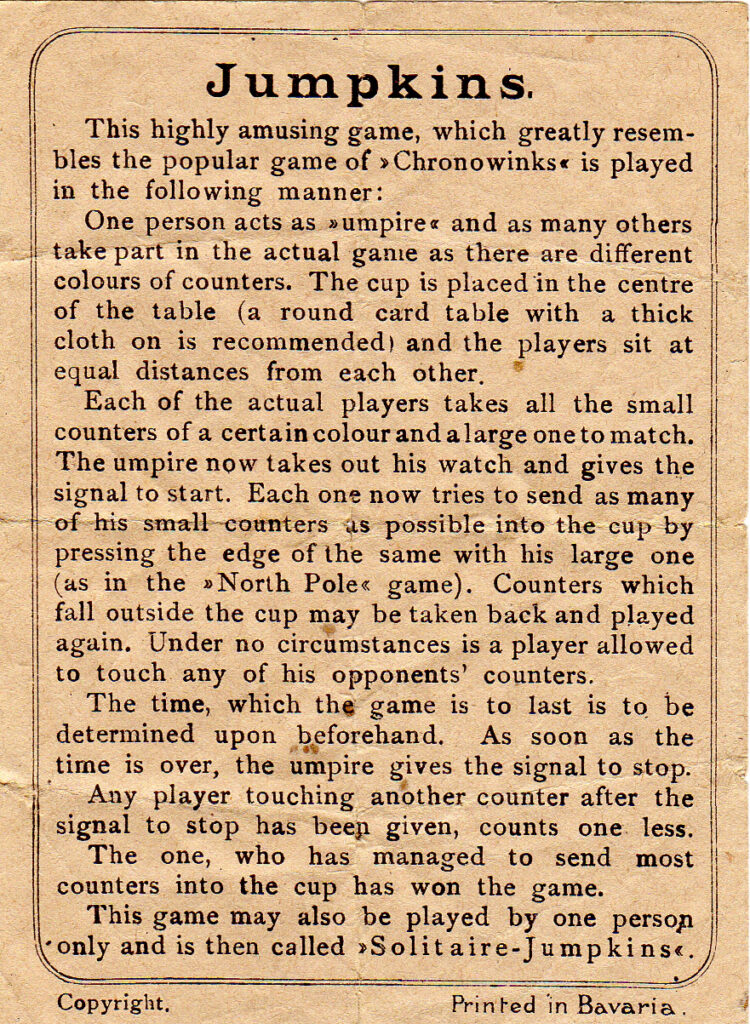
title • THE NEW GAME OF JUMPKINS
publisher • J. W. Spear & Sons
item • rules
photograph by • Rick Tucker
source • Tucker Tiddlywinks Collection
licenseable • per Creative Commons CC BY-SA 4.0
1892 • Sweet Wedding Bells • first published by Eyre & Spottiswoode
A musical tiddlywinks game of Victorian vintage is reported by Brian Jewell (in Sports & Games: History and Origins, 1977): a “Tiddlywinks Tower [which] was a miniature bell tower made from either tin plate or wood. The object was to flick the tiddlywink into one of the window openings and so ring the bell.”
Ignaz Sulzbacher patented a tiddlywinks bell tower device (patent # GB 1892/05482 A) on 19 March 1892.
The first version of this game was published by Eyre & Spottiswoode (which is curiously misspelled as “Spootiswoode” on the rules).
“PATENTED IN GT. BRITAIN No. 5482” appears at lower right on the cover of this game, which corresponds to the identifier for the Ignaz Sulzbacher patent.
The rules state that this is an “entirely new game”.
The game was made in Bavaria.
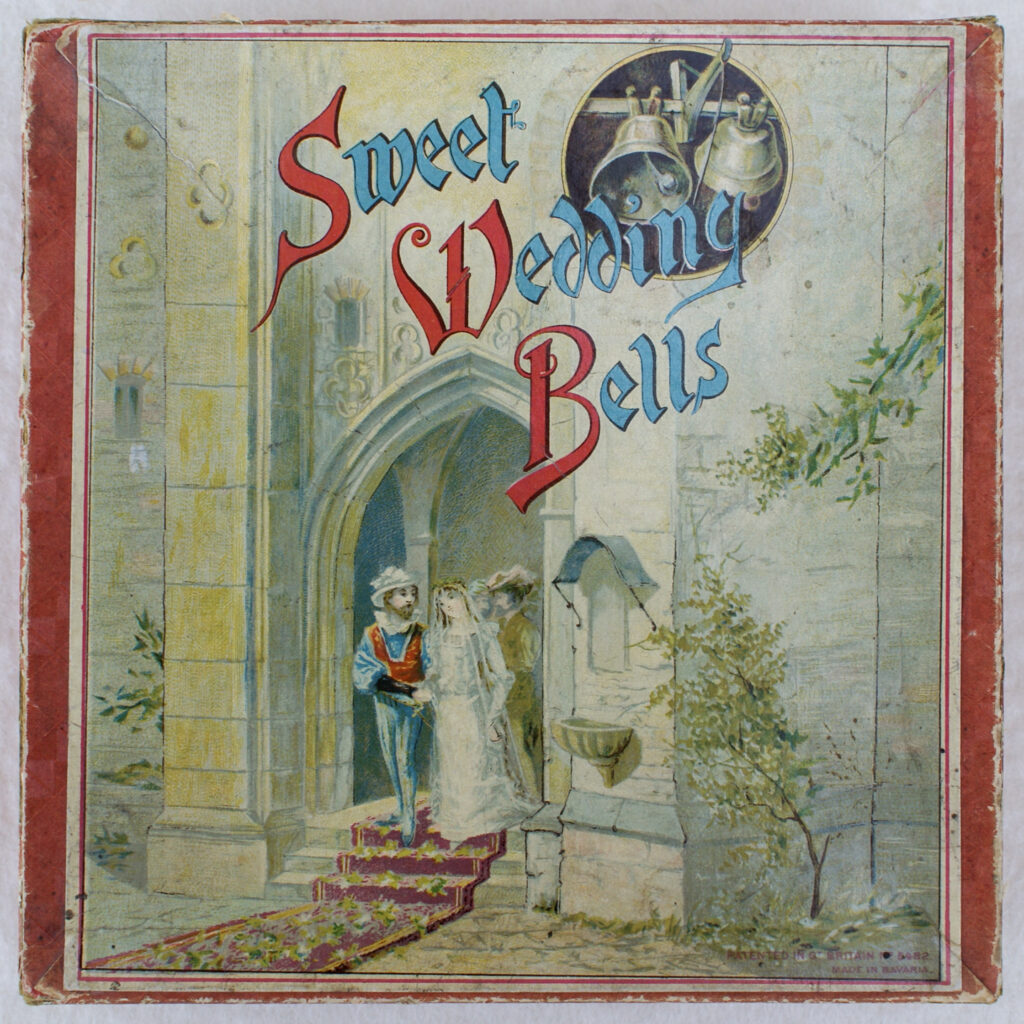
title • Sweet Wedding Bells
publisher • Eyre & Spottiswoode
item • cover
photograph by • Rick Tucker
original in • Tucker Tiddlywinks Collection
licenseable per Creative Commons CC BY-SA 4.0
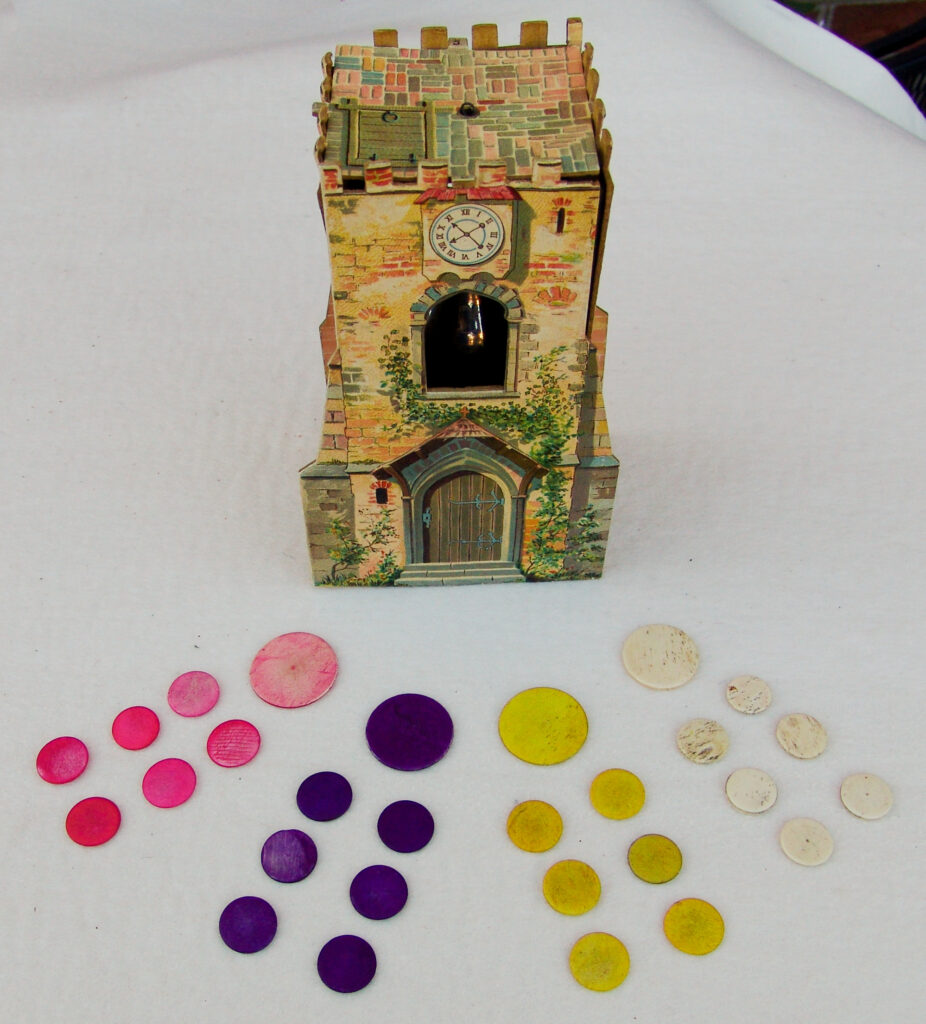
title • Sweet Wedding Bells
publisher • Eyre & Spottiswoode
item • bell tower target, squidgers, and winks
photograph by • Rick Tucker
original in • Tucker Tiddlywinks Collection
licenseable per Creative Commons CC BY-SA 4.0
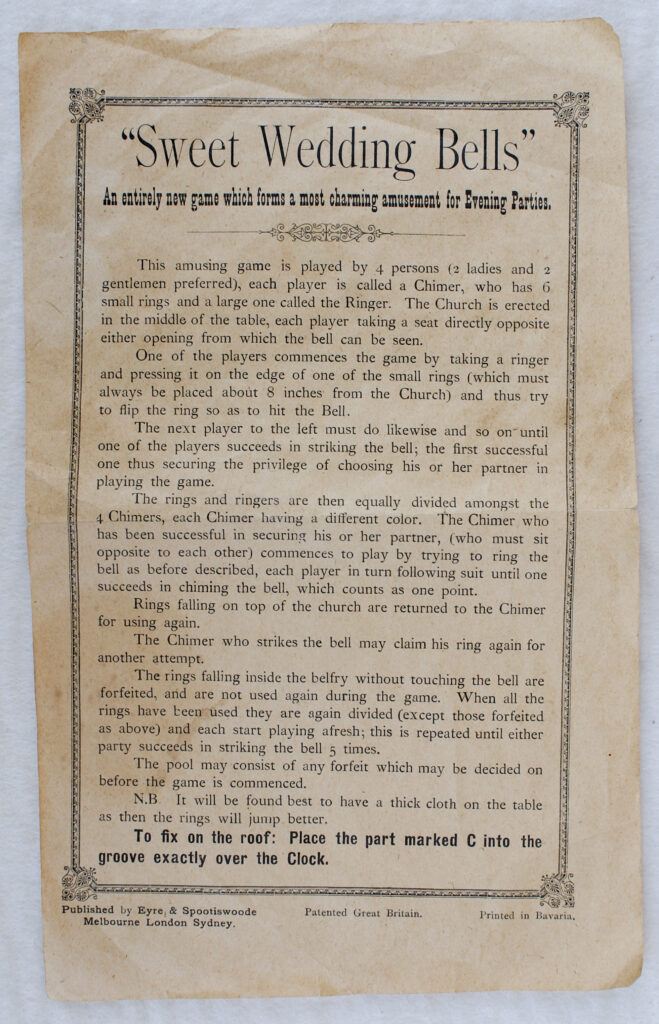
title • Sweet Wedding Bells
publisher • Eyre & Spottiswoode
item • rules sheet
photograph by • Rick Tucker
original in • Tucker Tiddlywinks Collection
licenseable per Creative Commons CC BY-SA 4.0
Sulzbacher along with Emil Oppenheimer produced games under the Globe Series brand. Another edition of Sweet Wedding Bells is marked « “Globe” Series of Games » on the cover along with a globe logo, which is given as a “TRADE MARK”.
The rules for this edition refer to the game as a “WELL KNOWN GAME”. The rules are contained in an advertising booklet for a range of Globe Series games, such as Callopea, Checkmate, Pigmy Wife, and Flipperty Flop. Flipperty Flop is a tiddlywinks-style game, described above.
Some of rules text is slightly different from the Eyre & Spottiswoode edition, though the game play is identical.
This game was made in Bavaria.
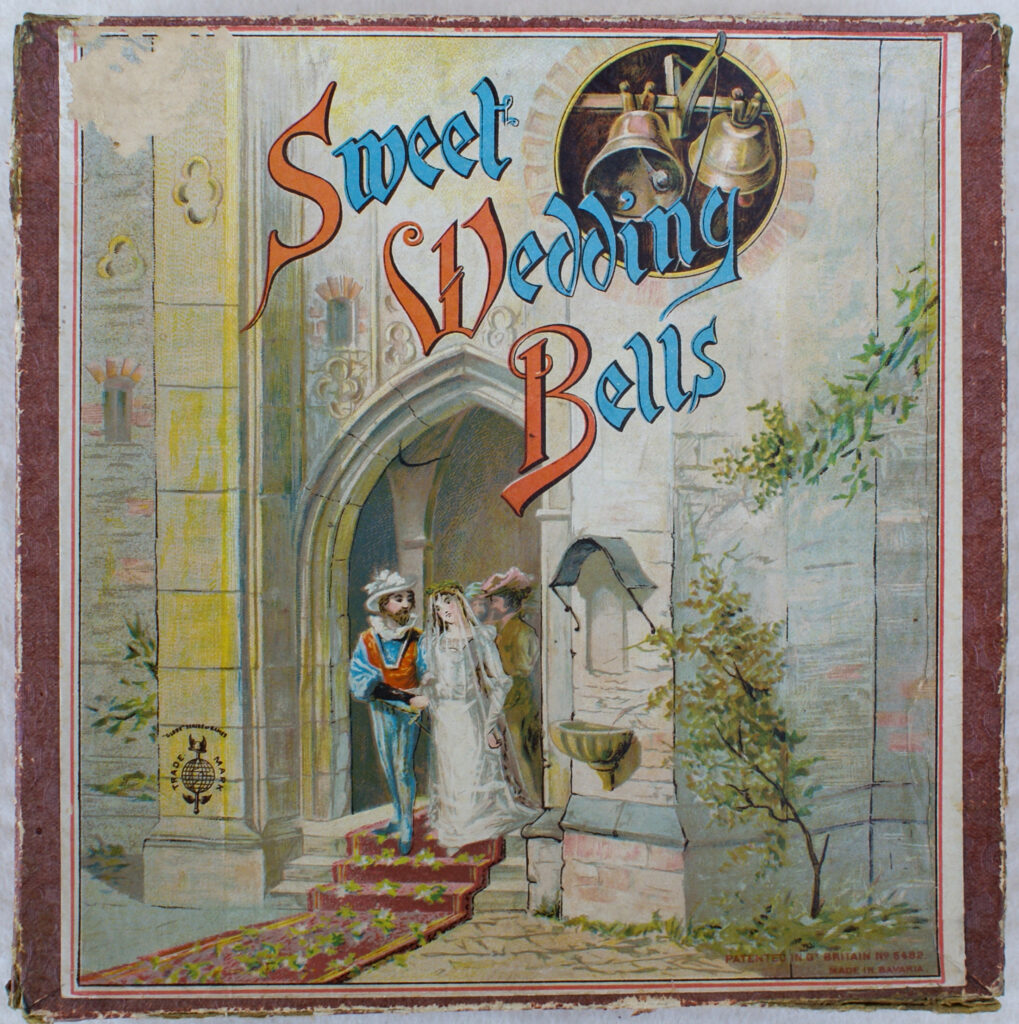
title • Sweet Wedding Bells
publisher • Globe Series of Games
item • game cover
photograph by • Rick Tucker
original in • Tucker Tiddlywinks Collection
licenseable per Creative Commons CC BY-SA 4.0
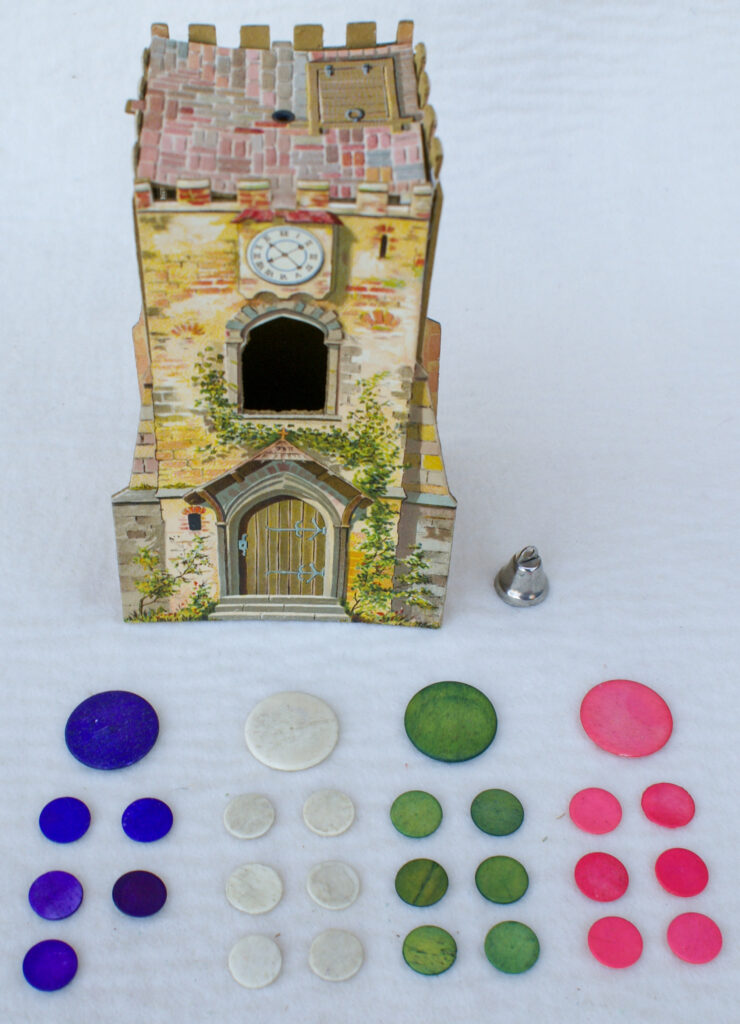
title • Sweet Wedding Bells
publisher • Globe Series of Games
item • contents
photograph by • Rick Tucker
original in • Tucker Tiddlywinks Collection
licenseable per Creative Commons CC BY-SA 4.0
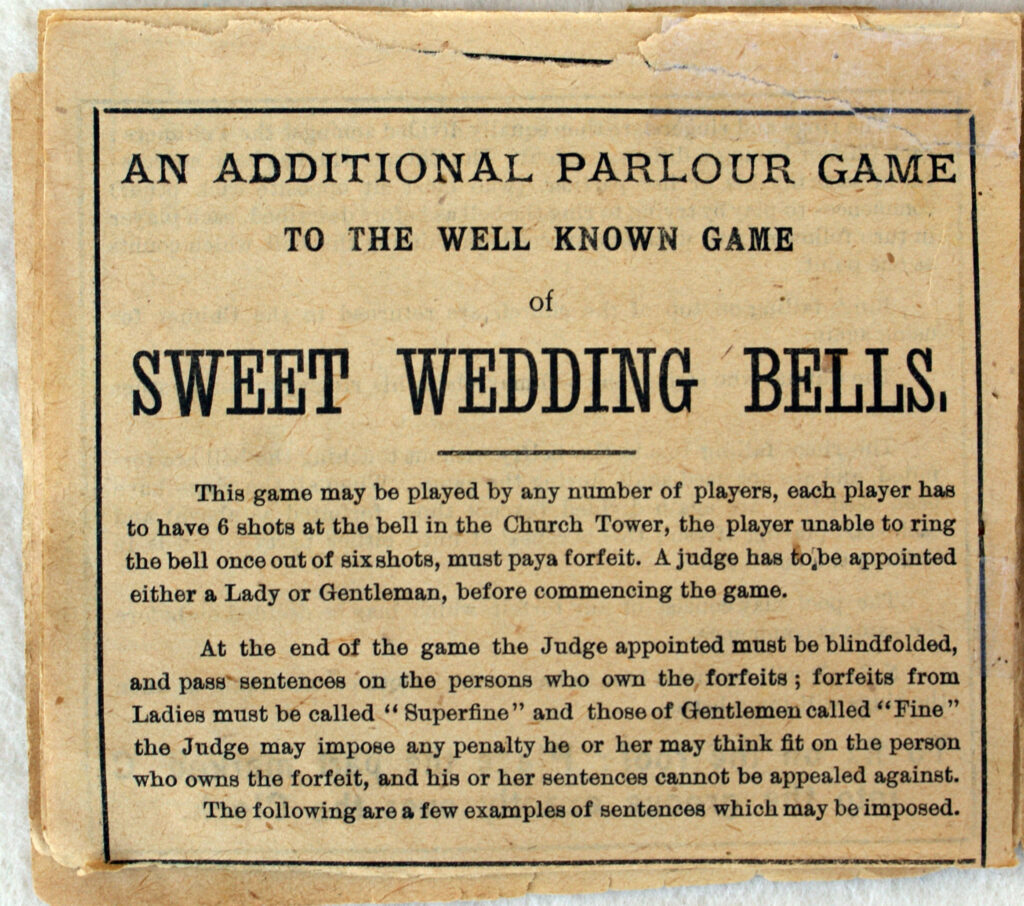
title • Sweet Wedding Bells
publisher • Globe Series of Games
item • advertising and rules booklet, one page
photograph by • Rick Tucker
original in • Tucker Tiddlywinks Collection
licenseable per Creative Commons CC BY-SA 4.0
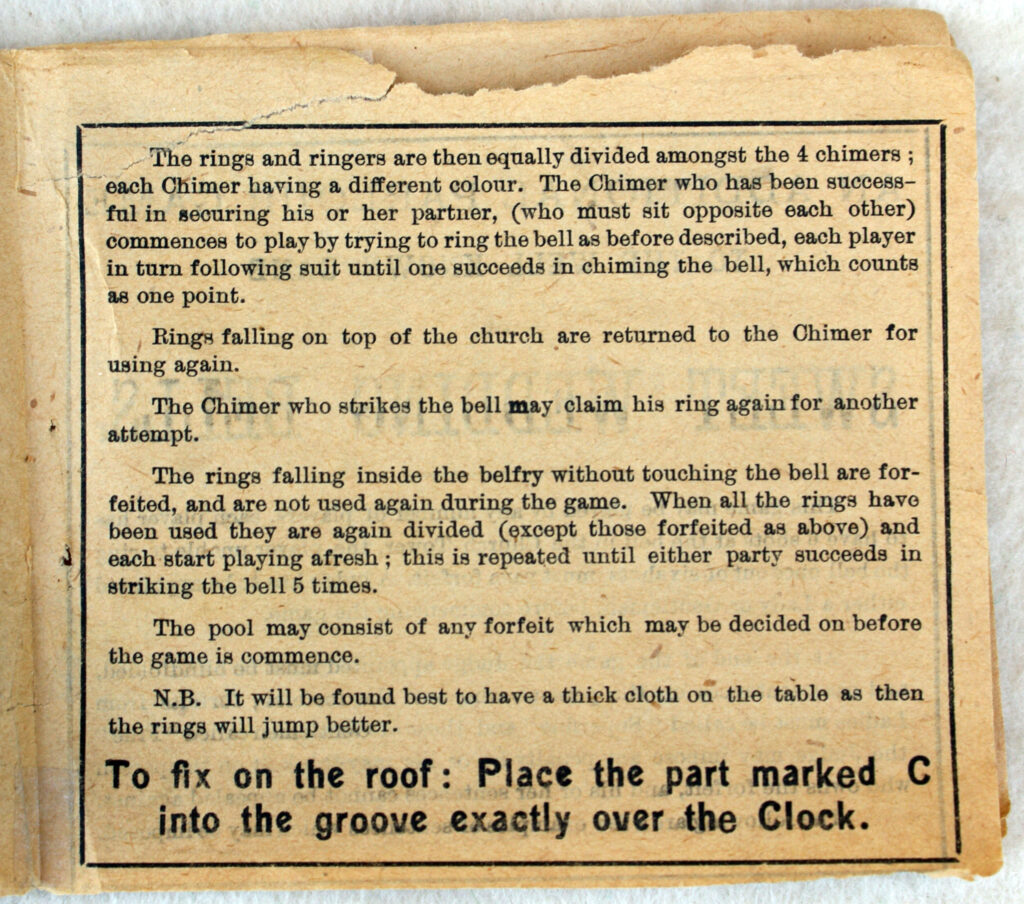
title • Sweet Wedding Bells
publisher • Globe Series of Games
item • advertising and rules booklet, additional page
photograph by • Rick Tucker
original in • Tucker Tiddlywinks Collection
licenseable per Creative Commons CC BY-SA 4.0
Spear’s Games produced another version of this game, called Sweet Wedding Bells – A Novel Game of Tidley Winks, in 1930 and thereabouts.The game was designed in Great Britain and manufactured at the Spear Works in Bavaria.
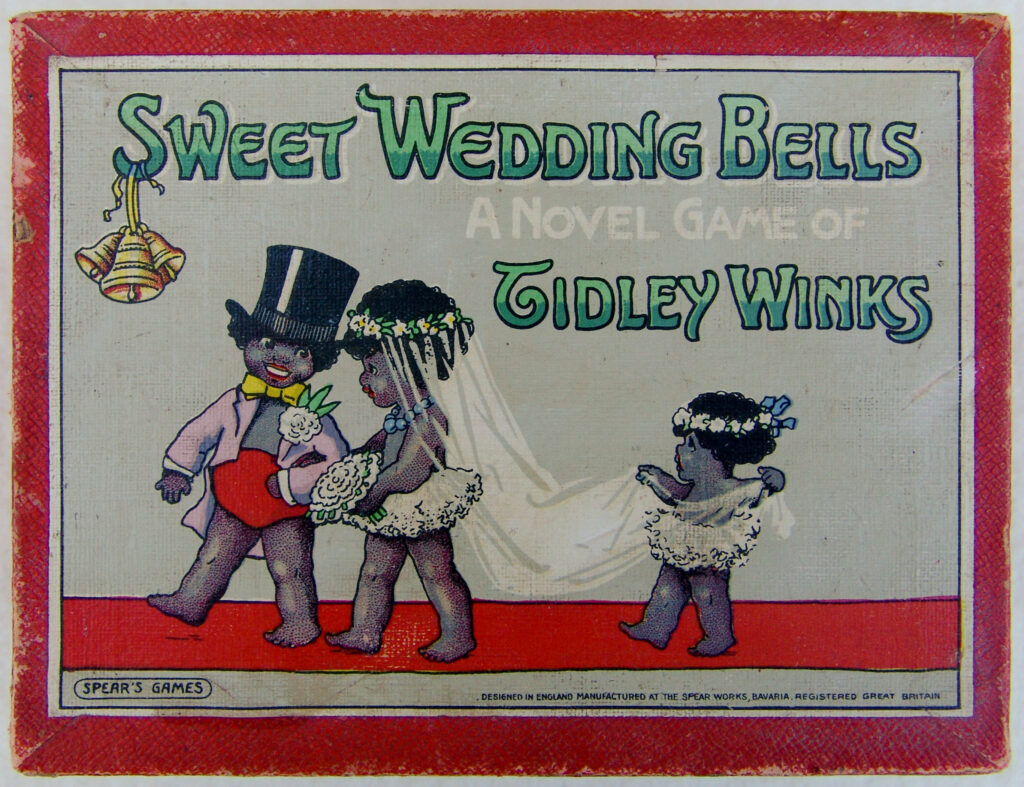
title • Sweet Wedding Bells - A Novel Game of Tidley Winks
publisher • Spear's Games
date • 1930 (Spear Game Archive)
item • game cover
photograph by • Rick Tucker
original in • Tucker Tiddlywinks Collection
licenseable per Creative Commons CC BY-SA 4.0
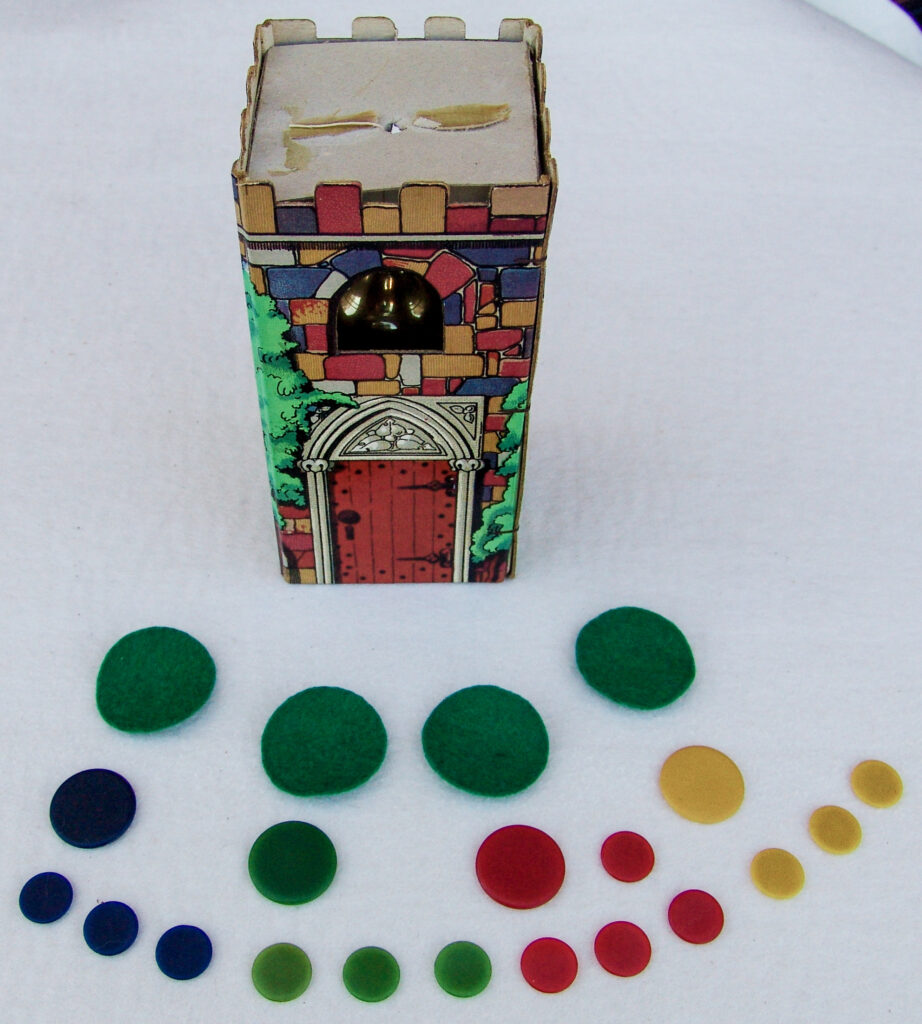
title • Sweet Wedding Bells - A Novel Game of Tidley Winks
publisher • Spear's Games
date • 1930 (Spear Game Archive)
item • contents
photograph by • Rick Tucker
original in • Tucker Tiddlywinks Collection
licenseable per Creative Commons CC BY-SA 4.0
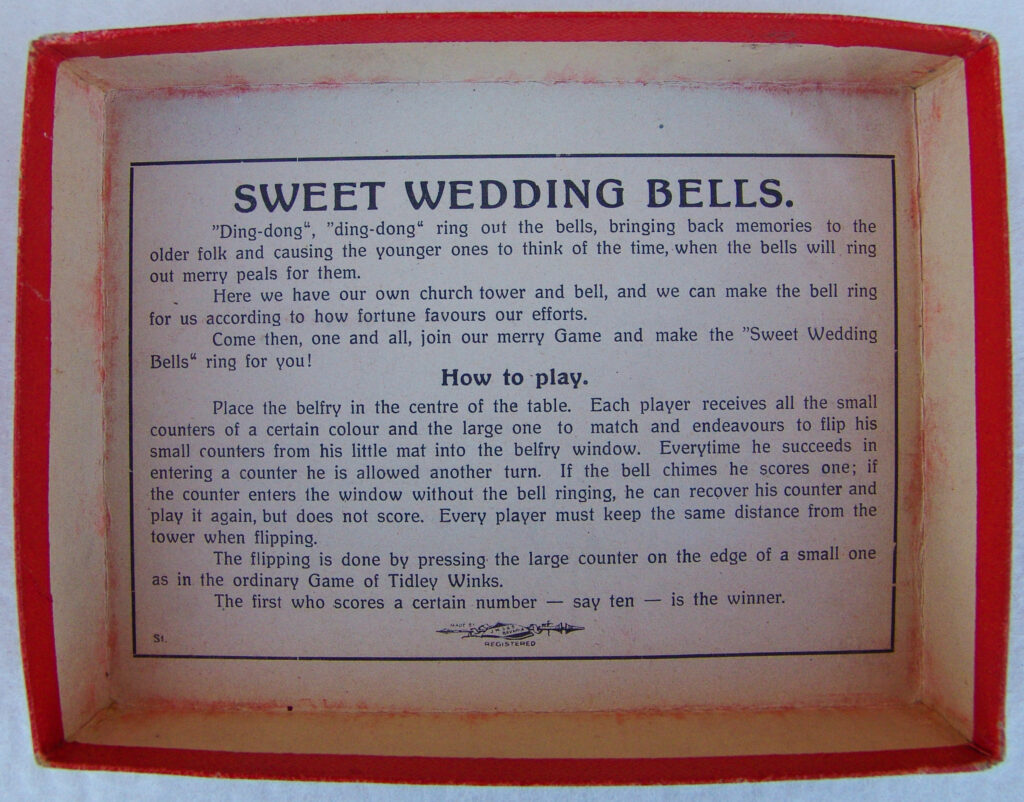
title • Sweet Wedding Bells - A Novel Game of Tidley Winks
publisher • Spear's Games
date • 1930 (Spear Game Archive)
item • rules under box lid
photograph by • Rick Tucker
original in • Tucker Tiddlywinks Collection
licenseable per Creative Commons CC BY-SA 4.0
1890 • North Pole • published by J. W. Spear & Sons
Carl Spear, a principal of the company J. W. Spear & Sons, copyrighted the cover illustration and rules for A NEW GAME – THE NORTH POLE, a game designed in England and manufactured in Fürth, Bavaria. When he submitted the copyright, he stated his place of publication to be at Klein’s Hotel in Finsbury Square in London. This game is, of course, a tiddlywinks-style game, as evidenced by the rules for the game shown below, though the polar bear on ice in the cover illustration leads one to wonder what this game is all about! The rules state that a map is used as the playing surface, with the north pole as the ultimate goal worth 1000 points, while other players count points according to the degrees of latitude reached by players’ counters.
1891 • Over the Garden Wall • published by J. W. Spear & Son
The game Over the Garden Wall was copyrighted in England by Carl Spear of the J. W. Spear & Sons company on 26 June 1891, as “Over the garden wall • Invented by Jip • Designed by Jap.” Jip was given credit for a variety of Spear games.
The target in this game is in the box bottom with vertical inserts along all edges, requiring the player to shoot winks over the inserts onto the target elements in the box bottom. A variety of metal targets are placed on the box bottom, including a round fenced-in area and trees.
J. W. Spear & Sons published this game in the United Kingdom, though it was printed in Bavaria.
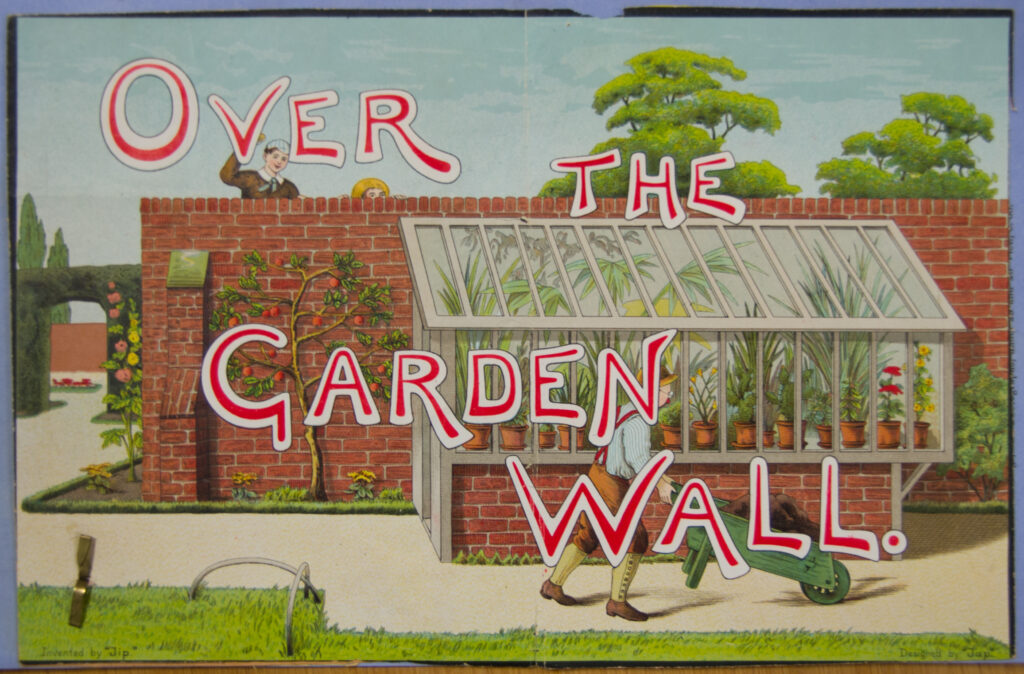
title • Over the Garden Wall
publisher • J. W. Spear & Sons
item • cover
first publication, copyright application date • 26 June 1891
photograph by • Rick Tucker
original at • National Archives, Kew, England
original also in • Tucker Tiddlywinks Collection
licenseable • per Creative Commons CC BY-SA 4.0
![Tucker Tw ID • SPE-08c1 — AGPI ID • G-32412c1 — publisher • J. W. S. [Spear] & S. (made in B — title • OVER THE GARDEN WALL — notes • Entered at Stationers' Hall. Copyright.](https://tiddlywinks.org/wp-content/uploads/2022/10/SPE-08c1_G-32412c1-Spears-Games-SPE-OVER-THE-GARDEN-WALL-Entered-at-Stationers-Hall.-Copyright.-DSC00252-fom-Rick-Tucker-Collection-1024x903.jpg)
title • Over the Garden Wall
publisher • J. W. Spear & Sons
item • game target and winks
first publication, copyright application date • 26 June 1891
photograph by • Rick Tucker
original at • Tucker Tiddlywinks Collection
licenseable • per Creative Commons CC BY-SA 4.0
The same game was published in the United States by E. I. Horsman (Tucker Tw ID • HOR-02 — AGPI ID • G-29862), using the same cover illustration and game implements, which is in the collections of the Lilly Library of Indiana University. E. I. Horsman copyrighted the game in 1893.

1891 • Flutter • rules by Albert Joseph Altman • published by Feltham & Co.
The rules for the game of Flutter were copyrighted in 1891 by Albert Joseph Altman (1839–1912), and the game was published by Feltham & Co.
Albert Joseph Altman, of the City Steam Works at 60 Barbican in London, went on to patent a variety of improvements to nontiddlywinks games such as croquet hoops (1894), lawn-tennis (1897), polo, golf, and the like. In 1897 he included the title “Sir” in a patent application. His occupation in some patents was given as “Manufacturer of sporting goods”. Starting in 1876, he chaired the Special Bridge or Subway Committee charged with determining how to transport people across the Thames, which subsequently resulted in the building of the Tower Bridge across the river Thames in London.
Albert Altman was listed as a Managing Director of Feltham & Co. Ltd., and Percy A. J. Altman as Director, in another non-tiddlywinks patent in 1898. In that same patent, the address of Feltham & Co. Ltd. is given as Victoria Steam Works, Gillingham Street, Victoria, London S.W.
The Feltham & Co. company was best known for selling tennis rackets.
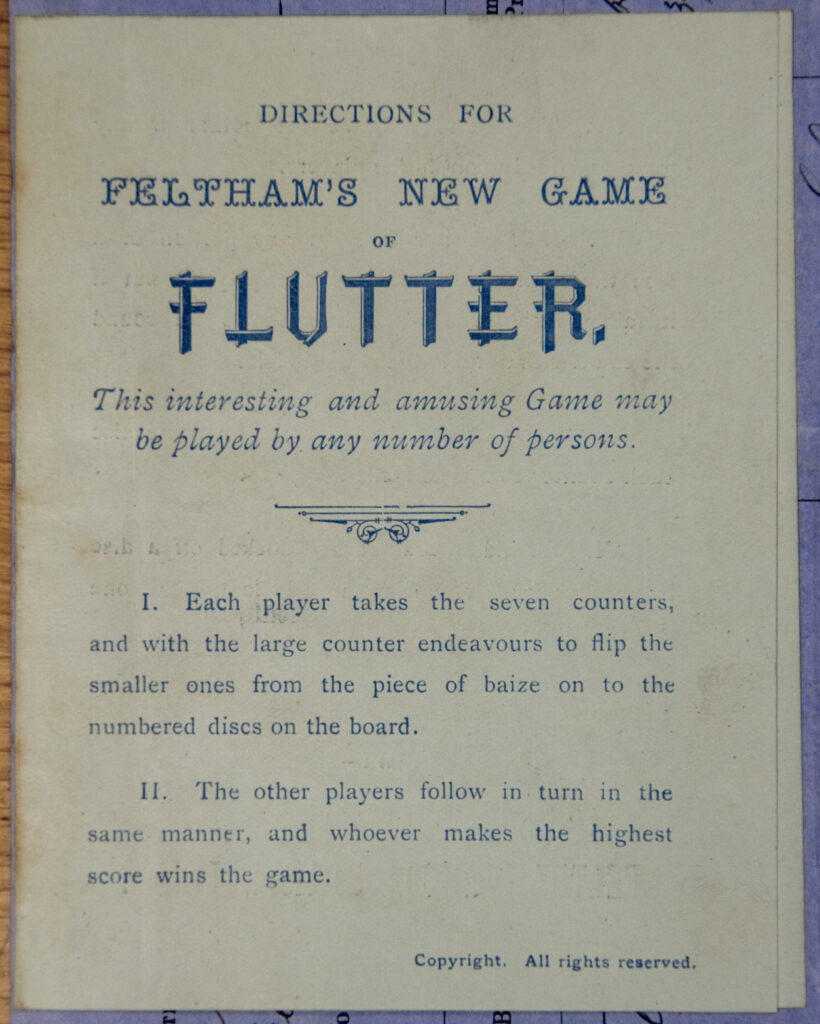
title • Flutter
publisher • Feltham & Co., Barbican, London
first published date • 12 August 1891
copyright claimant • Albert Joseph Altman
copyright application date • 13 August 1891
item • rules, page 1
photograph by • Rick Tucker
original at • National Archives, Kew, England
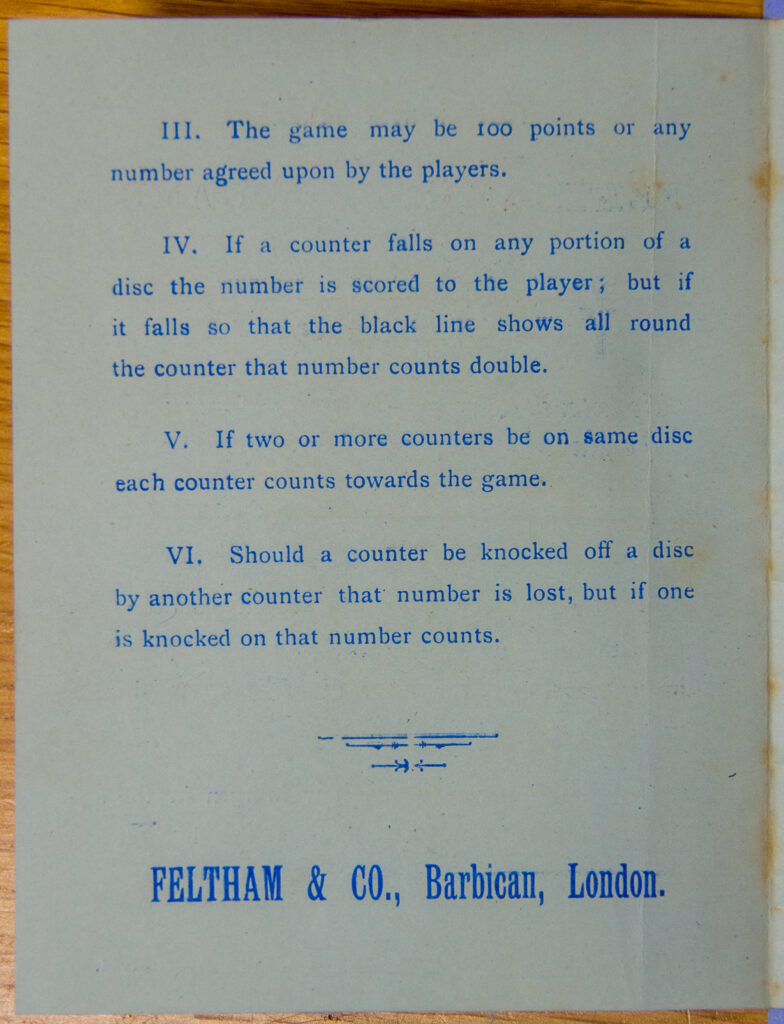
title • Flutter
publisher • Feltham & Co., Barbican, London
first published date • 12 August 1891
copyright claimant • Albert Joseph Altman
copyright application date • 13 August 1891
item • rules, page 2
photograph by • Rick Tucker
original at • National Archives, Kew, England
1890 • Raccroc • copyrighted by Arthur J. Edwards
Both the cover and rules to The New Game of Raccroc (pronounced as Ra-Crow according to the rules) were copyrighted by Arthur J. Edwards in 1890. Neither the cover of the game nor the rules identify the name of the publisher of this tiddlywinks game.
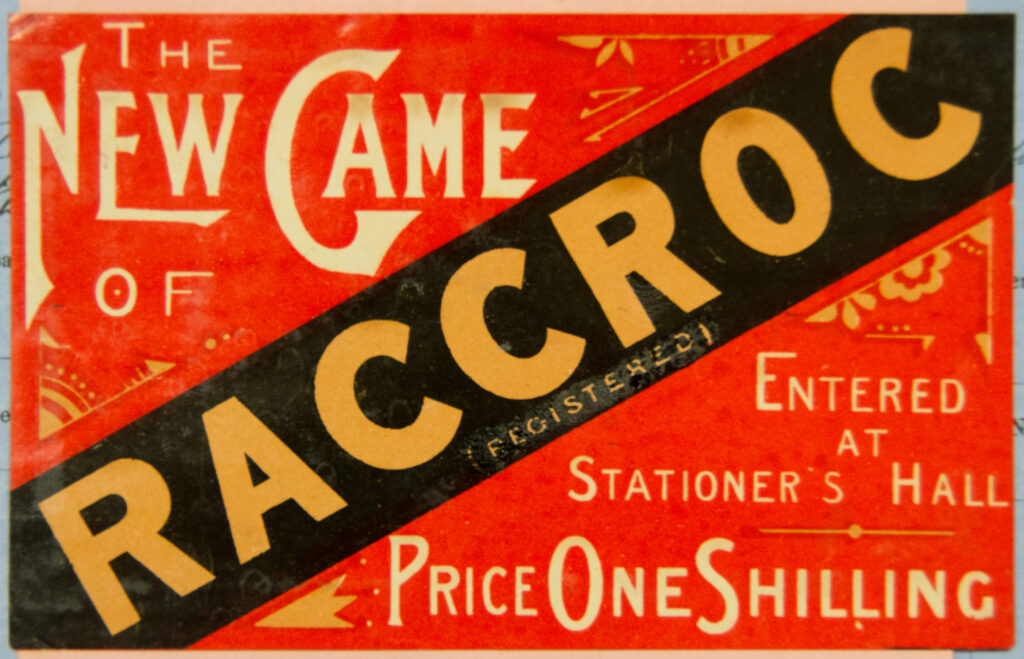
title • The New Game of Raccroc
publisher • unknown
item • cover
copyright claimant • Arthur J. Edwards
first publication date • 26 September 1890
copyright application date • 11 November 1890
photograph by • Rick Tucker
original at • National Archives, Kew, London
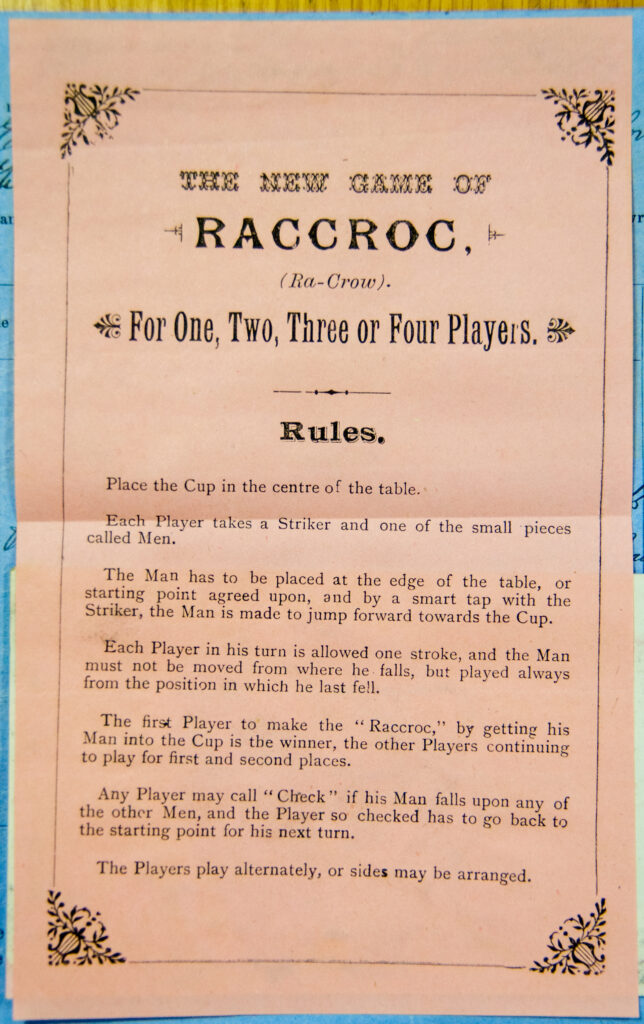
title • The New Game of Raccroc
publisher • unknown
item • rules
copyright claimant • Arthur J. Edwards
first publication date • 26 September 1890
copyright application date • 11 November 1890
photograph by • Rick Tucker
original at • National Archives, Kew, London
1891 • Chronowinks • published by J. W. Spear & Son
The New Game of Chronowinks was copyrighted by Carl Spear of the J. W. Spear & Sons company on 26 June 1891 as “The new game of Chronowinks. Invented by Jip.” Its rules refer to another Spear tiddlywinks game, North Pole, which is shown earlier in this article. Each game is limited to the time it takes for all of the sand to drop from the top of an hourglass. The rules also refer to a solitaire version of the game.
1890 • Flips • by William Bryce (Toronto)
The book and game publisher William M. Bryce of Toronto, Ontario, Canada came out with the New Parlor Game – Flips, selling for 25 cents Canadian. According to the rules, this game was:
Entered according to Act or Parliament of Canada, in the Office of the Minister of Agriculture, by WILLIAM BRYCE, in the year one thousand eight hundred and ninety.
In other words, the rules for the game were copyrighted. But via the Minister of Agriculture? Well, er, yes!
With Confederation in 1867, the federal Department of Agriculture was created. Under Section 95 of the British North America Act, the federal and provincial governments were granted concurrent (shared) jurisdiction over agriculture. The post-Confederation Department of Agriculture continued to be assigned numerous responsibilities in addition to those related to agriculture. These included arts and manufactures, archives, immigration, quarantine and public health, the marine and emigrant hospital at Quebec, the census and statistics, patents, copyrights, trademarks and industrial design.
Smithsonian's Lemelson Center for the Study of Invention and Innovation, Government of Canada Department of Agriculture Fonds, 1845-1990, 23 July 2014, retrieved 30 November 2022
This game of FLIPS was produced in two editions, No. 1 for 4 players at 25 cents, and No. 2 for 6 players at 50 cents.
Rule 5 talks about squopping opponents:
5.—On no account is a player allowed to touch his opponent's counters, so that, should it so happen that accidentally one of his adversary's men in a ny way covers the counter he wishes to play with (no other being available), he must wait until his opponent has removed the counter before he can play. A player may not intentionally cover his opponent's counters.
![[+template:(Tucker Tw ID • [+xmp:title+] — publisher • [+iptc:source+] — title • [+xmp:headline])+]](https://tiddlywinks.org/wp-content/uploads/2022/11/BRY-01-_-G-37934-_-William-Bryce-_-NEW-PARLOR-GAME-FLIPS-cover-IMG_0888-1024x781.jpeg)
title • NEW PARLOR GAME FLIPS
publisher • William Bryce (Toronto)
item • cover
photograph by • Rick Tucker
original at • Tucker Tiddlywinks Collection
licenseable • per Creative Commons CC BY-SA 4.0
1892 (or earlier) • Hup-Lah
![[+template:(Tucker Tw ID • [+xmp:title+] — publisher • [+iptc:source+] — title • [+xmp:headline])+]](https://tiddlywinks.org/wp-content/uploads/2022/11/UNK-141-_-G-37949-_-Unknown-British-_-Huplah-cover-IMG_0886-1024x705.jpeg)
title • THE NEW & EXCITING GAME OF HUP LAH
publisher • (unknown, British)
item • game cover
photograph by • Rick Tucker
original at • Tucker Tiddlywinks Collection
licenseable • per Creative Commons CC BY-SA 4.0
![[+template:(Tucker Tw ID • [+xmp:title+] — publisher • [+iptc:source+] — title • [+xmp:headline])+]](https://tiddlywinks.org/wp-content/uploads/2022/11/UNK-141-_-G-37949-_-Unknown-British-_-Huplah-contents-IMG_0887-985x1024.jpeg)
title • THE NEW & EXCITING GAME OF HUP LAH
publisher • (unknown, British)
item • contents
photograph by • Rick Tucker
original at • Tucker Tiddlywinks Collection
licenseable • per Creative Commons CC BY-SA 4.0
1894 • "Salomo" • invented by H. O. Roberts • published by Thomas Ordish & Co.
Two sides of one or more players each can play the game of “Salomo”. One side plays white winks and the other, red ones, using squidgers that are larger than the winks. The game target is a checkers board, which is called draughts in the UK. According to the rules:
THE GAME Is to flip the men on to the squares of tbe board, this being done by pressing the edge of one of them with the large counter provided, causing it to jump. For every man so placed the player is entitled to another turn. When a man has been got on to the board, the player may with it, take his opponents’ men. as in the game of Draughts, those so taken being placed on the table, to be reflipped subsequently. The side that succeeds in getting all their men on the board first, wins the game.
Salomo was invented by Harry Owen Roberts, who was the manager of Mineral Water Factory in Gloucester. He patented the game (British patent number GB189405866A) in 1894. The provisional patent specification was submitted on 21 March 1894, the complete specification on 10 August 1894, and the patent was granted on 15 September 1894.
The rules were entered for copyright at Stationers Hall in London on 5 April 1894, noting their first publication on 31 March 1894.
Harry Owen Roberts and his brother John Owen Roberts, known as the Roberts Brothers, founded their own firm in 1894, selling many games without attribution, though usually marked British Manufacture. Later, they sold games under the name Glevum Series of Games, and later, Glevum Games.
- Malcolm J. Watkins, Roberts Brothers: Game Makers to the Empire, page 17, Gloucestershire, England UK: Heritage Matters, © 2013
- GlevumGames.com
![[+template:(Tucker Tw ID • [+xmp:title+] — publisher • [+iptc:source+] — title • [+xmp:headline])+]](https://tiddlywinks.org/wp-content/uploads/2022/11/ORD-01c1-_-G-38402-_-T-Ordish-Co-_-The-New-Game-of-Salamo-or-Flipping-Draughts-cover-IMG_0889-1-1024x564.jpeg)
title • THE NEW GAME of "SALOMO" OR FLIPPING DRAUGHTS
publisher • Thomas Ordish & Co. (99 Fore Street, London)
inventor • Harry Owen Roberts
item • game cover
photograph by • Rick Tucker
original at • Tucker Tiddlywinks Collection
licenseable • per Creative Commons CC BY-SA 4.0
![[+template:(Tucker Tw ID • [+xmp:title+] — publisher • [+iptc:source+] — title • [+xmp:headline])+]](https://tiddlywinks.org/wp-content/uploads/2022/11/ORD-01c1-_-G-38402-_-T-Ordish-Co-_-The-New-Game-of-Salamo-or-Flipping-Draughts-cover-close-up-IMG_0889-1024x605.jpeg)
title • THE NEW GAME of "SALOMO" OR FLIPPING DRAUGHTS
publisher • Thomas Ordish & Co. (99 Fore Street, London)
inventor • Harry Owen Roberts
item • game cover close-up
photograph by • Rick Tucker
original at • Tucker Tiddlywinks Collection
licenseable • per Creative Commons CC BY-SA 4.0
![[+template:(Tucker Tw ID • [+xmp:title+] — publisher • [+iptc:source+] — title • [+xmp:headline])+]](https://tiddlywinks.org/wp-content/uploads/2023/01/Tw-id-ORD-01-AGPI-id-G-38402-by-T-Ordish-Co-title-Salomo-rules-page-2-from-Malcolm-J-Watkins-email-2022-12-01.jpg)
The notable British journal Notes and Queries included a query indicating that Tiddledy-Winks had crossed the ocean to the Americas by January 1890:
Can any of your correspondents inform me what is the derivation of the word ‘kiddlewink,’ or ‘tiddledy winks’? A friend tells me in the Midland Counties it denotes a house where beer is sold without a licence. Lately a game has been introduced here bearing the name of ‘Tiddledywinks.’—M.D., Lamaha House, Georgetown, Demerara [in British Guiana].
Navigating Chapters
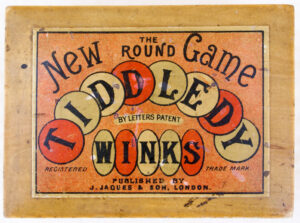
6 ❖ John Jaques & Son • Original Publishers of Tiddledy-Winks
It all started in 1795 when a spritely Thomas Jaques established himself as “Thomas Jaques: Manufacturer of Ivory, Hardwoods, Bone, and Tunbridge Ware.” Thomas took
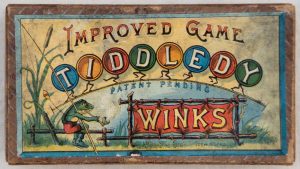
8 ❖ Conquering the U.S. • Tiddledy Winks
Now let us return to 1890. The name of the game quickly fell into the public domain starting in 1890 (though in the United States,
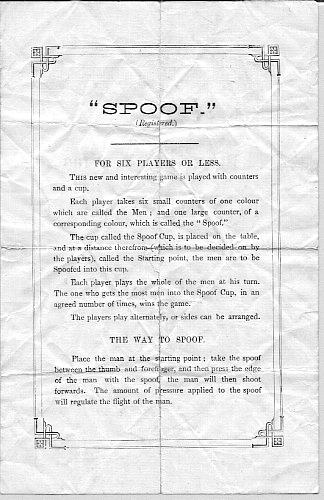
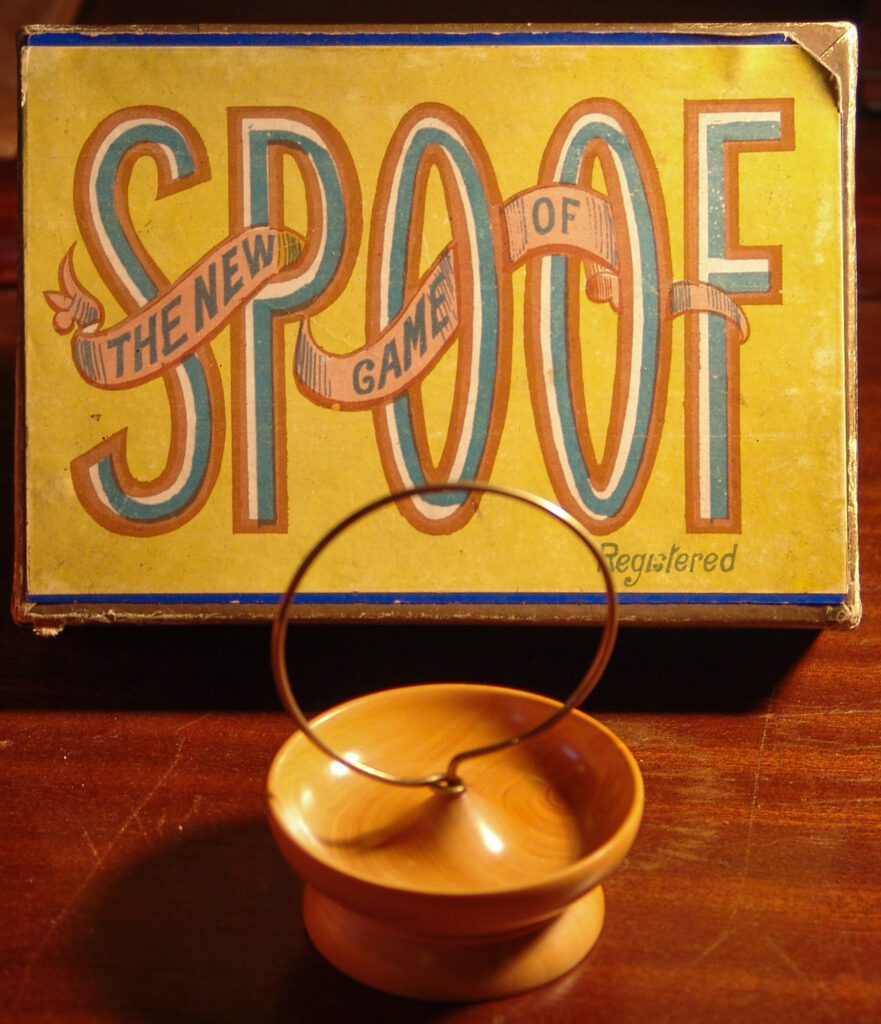
![[+template:(Tucker Tw ID • [+xmp:title+] — publisher • [+iptc:source+] — title • [+xmp:headline])+]](https://tiddlywinks.org/wp-content/uploads/2022/08/AYR-08_G-39654_F-H-Ayres_Spoof-Cricket-from-National-Archives-Kew-UK-DSC00691-660x1024.jpg)
![[+template:(Tucker Tw ID • [+xmp:title+] — publisher • [+iptc:source+] — title • [+xmp:headline])+]](https://tiddlywinks.org/wp-content/uploads/2022/07/1889-10-16-Trade-Marks-Journal-UK-page-985-re-FLITTERKINS-IMG_3385-2-trademark-1024x201.jpg)
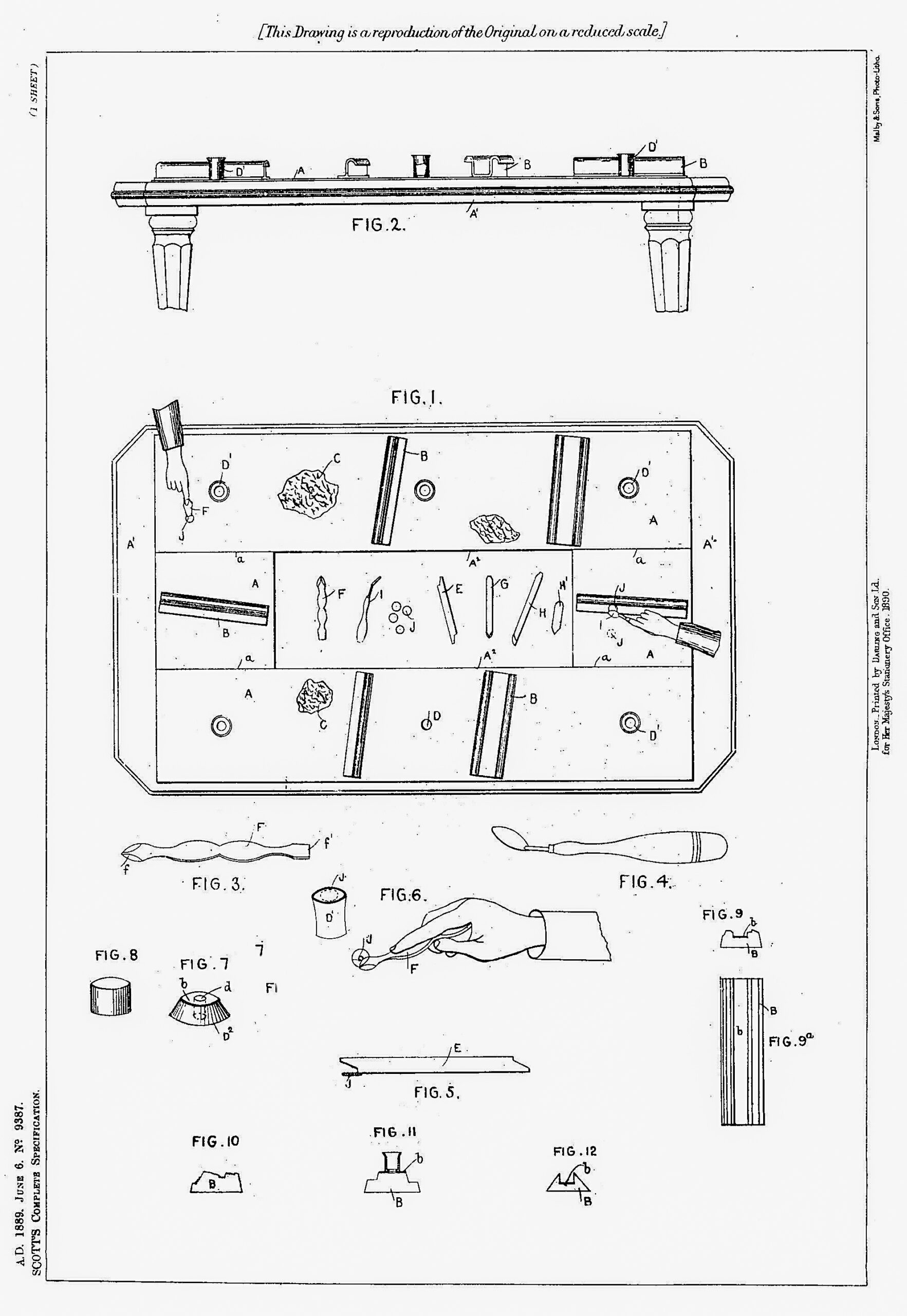
![[+template:(Tucker Tw ID • [+xmp:title+] — publisher • [+iptc:source+] — title • [+xmp:headline])+]](https://tiddlywinks.org/wp-content/uploads/2022/10/1890-07-15-George-Scott-patent-US000432170-1-scaled.jpg)

![[+template:(Tucker Tw ID • [+xmp:title+] — publisher • [+iptc:source+] — title • [+xmp:headline])+]](https://tiddlywinks.org/wp-content/uploads/2022/10/1889-06-06-copyright-item-Golfette-by-George-Scott-image-taken-2010-01-08a-National-Archives-Kew-SONY-DSC-DSC00545-fom-Rick-Tucker-Collection-792x1024.jpg)
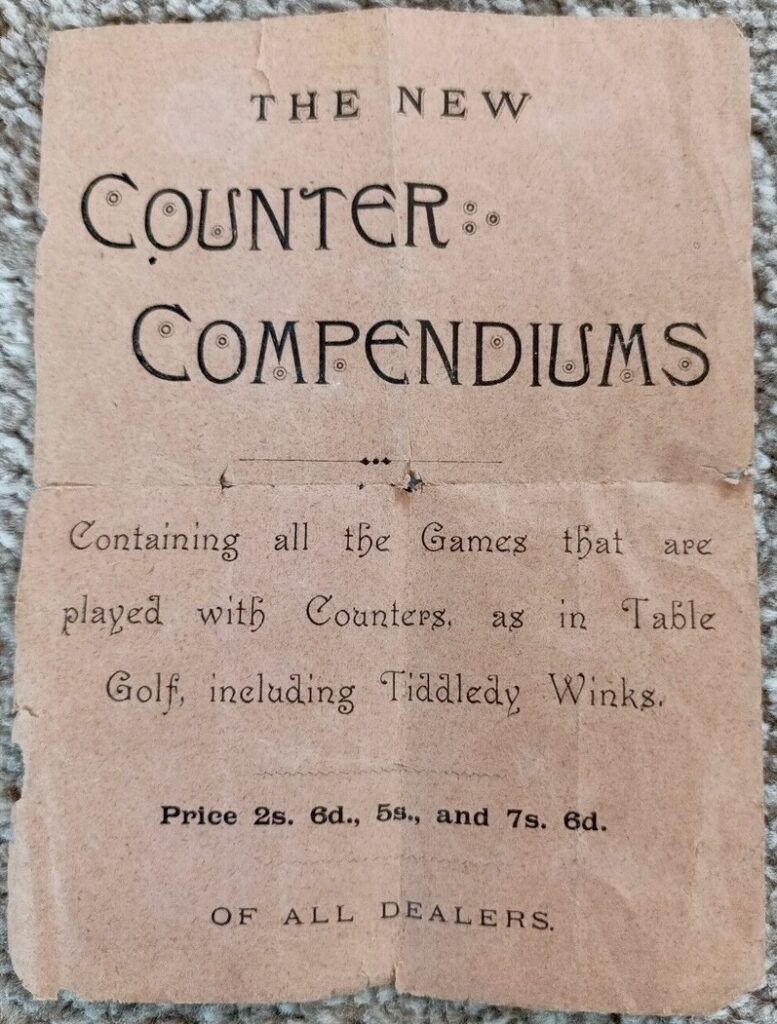
![[+template:(Tucker Tw ID • [+xmp:title+] — publisher • [+iptc:source+] — title • [+xmp:headline])+]](https://tiddlywinks.org/wp-content/uploads/2022/07/UK_Patent_5482_year-1892_p2-1-642x1024.jpg)
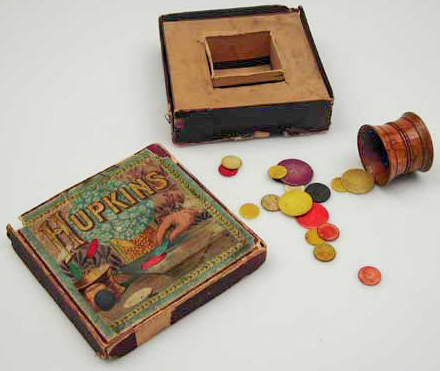
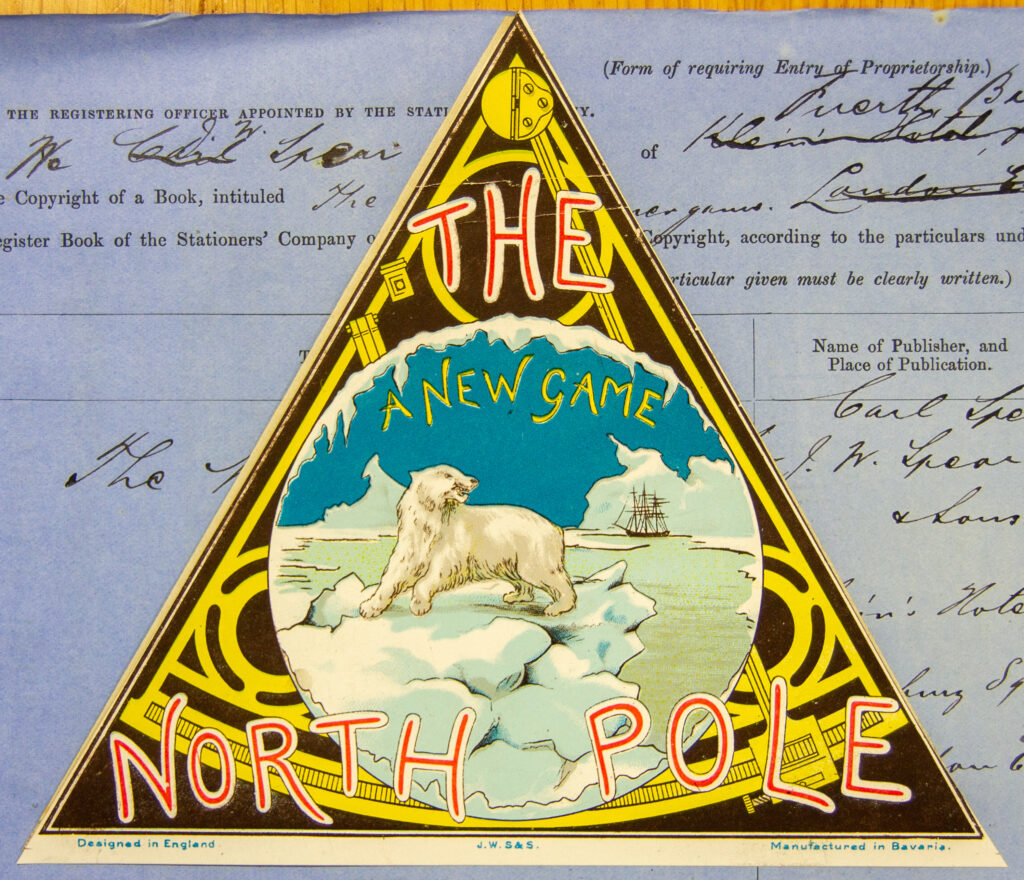
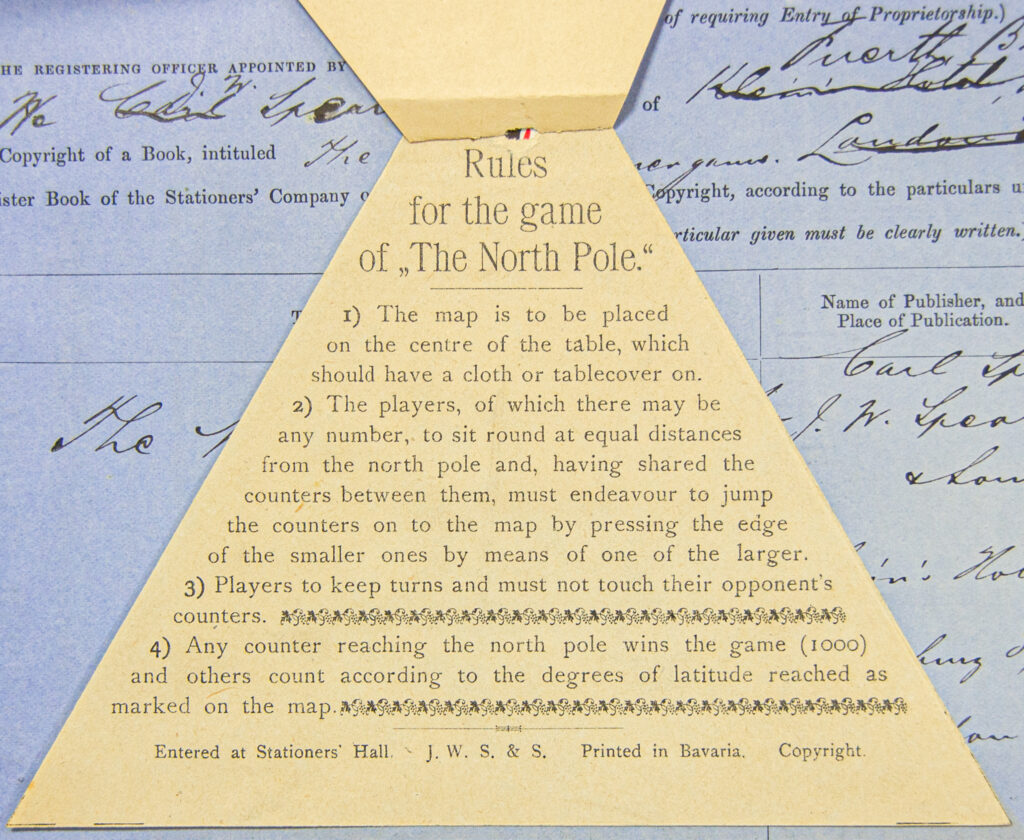
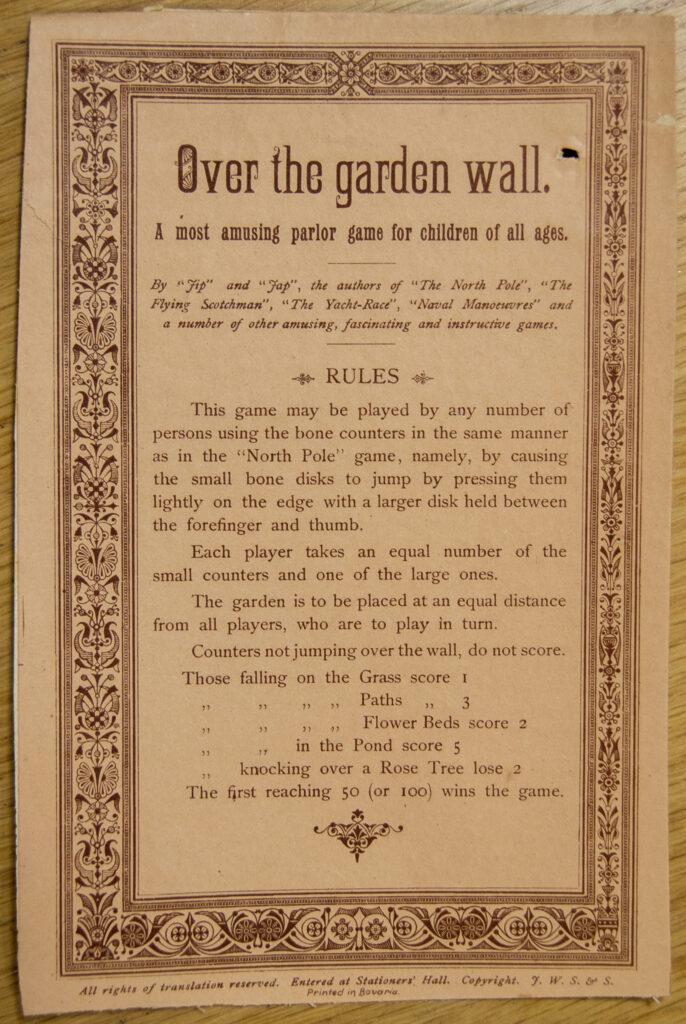
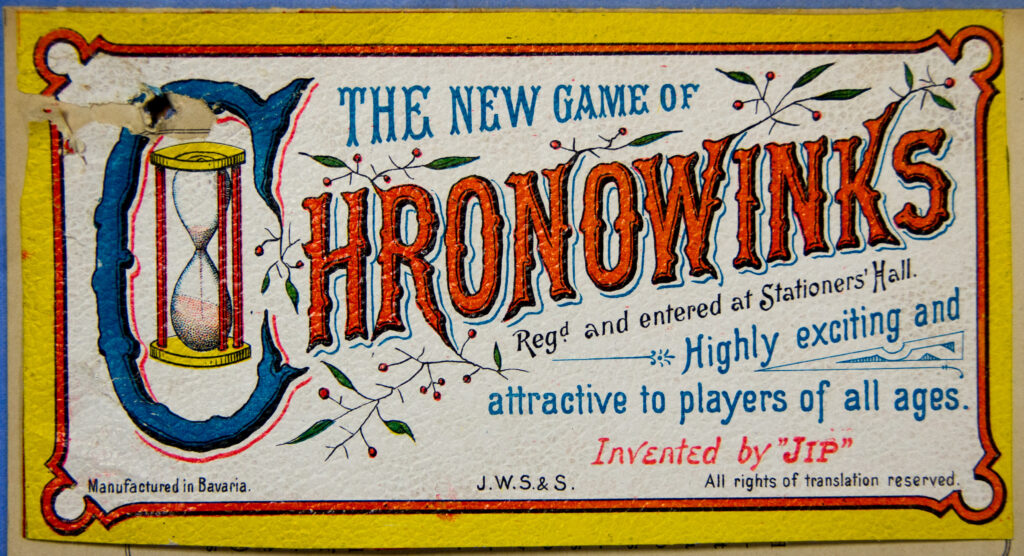
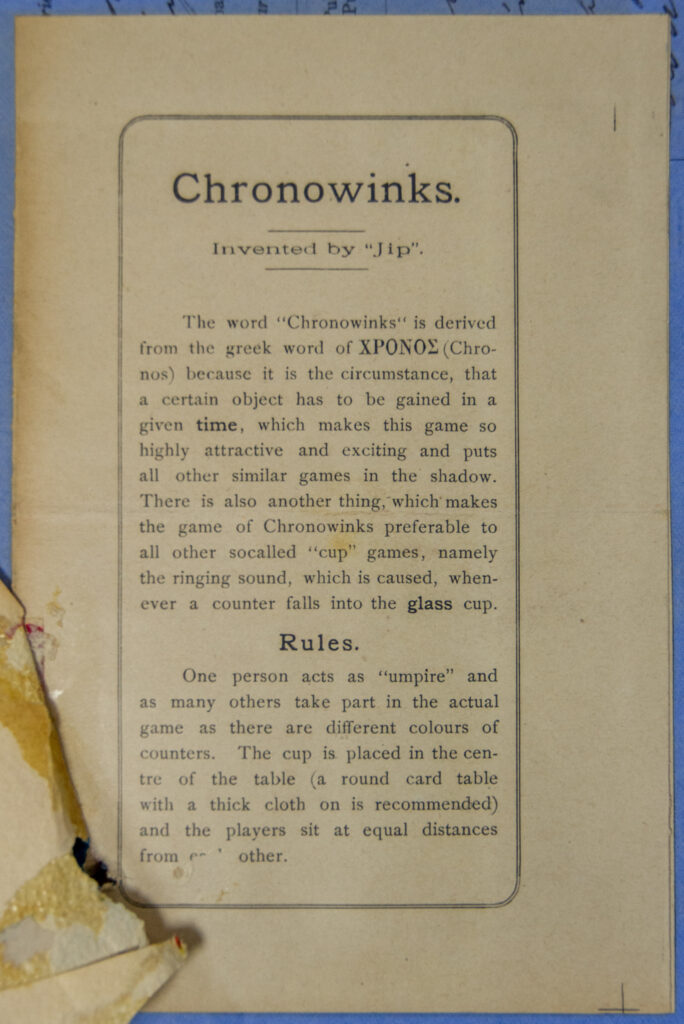
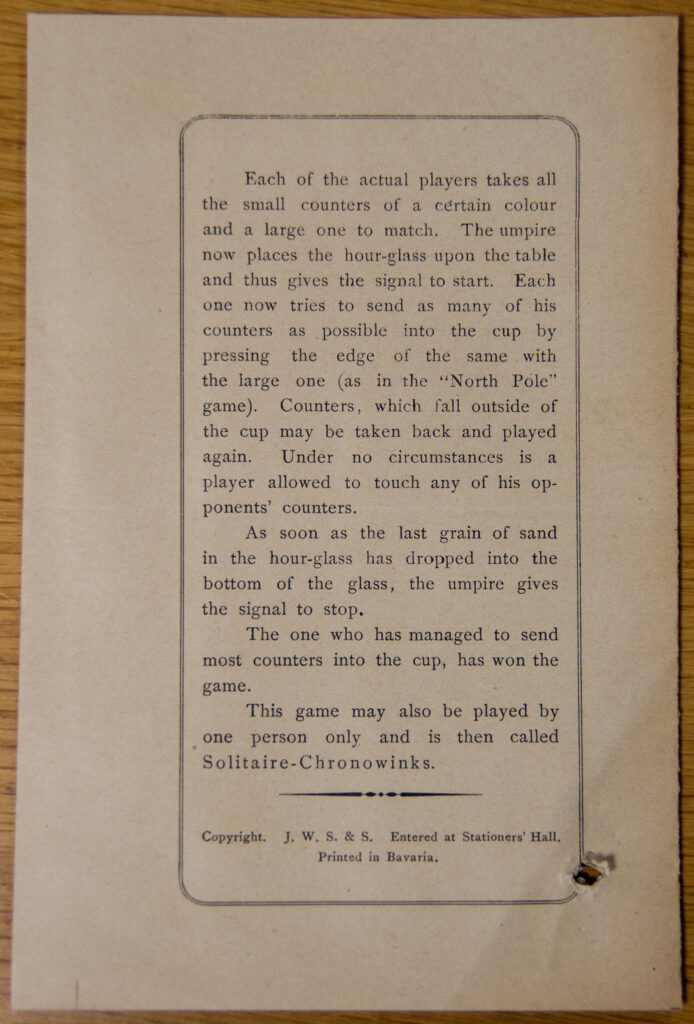
![[+template:(Tucker Tw ID • [+xmp:title+] — publisher • [+iptc:source+] — title • [+xmp:headline])+]](https://tiddlywinks.org/wp-content/uploads/2022/11/1891-12-10-Winnipeg-Tribue-page-4-col-5-re-Flips-game-twid-BRY-01-agpi-G-37934.jpg)
![[+template:(Tucker Tw ID • [+xmp:title+] — publisher • [+iptc:source+] — title • [+xmp:headline])+]](https://tiddlywinks.org/wp-content/uploads/2022/11/1892-10-28-Ripley-and-Heanor-News-England-page-4-column-1-re-Jumpkins-Hup-lah-1024x592.jpg)
![[+template:(Tucker Tw ID • [+xmp:title+] — publisher • [+iptc:source+] — title • [+xmp:headline])+]](https://tiddlywinks.org/wp-content/uploads/2022/11/1894-11-02-Gloucster-Citizen-England-item-ad-page-2-col-3-re-Salomo-game-1024x100.jpeg)
![[+template:(Tucker Tw ID • [+xmp:title+] — publisher • [+iptc:source+] — title • [+xmp:headline])+]](https://tiddlywinks.org/wp-content/uploads/2023/01/Tw-id-ORD-01-AGPI-id-G-38402-by-T-Ordish-Co-title-Salomo-rules-page-1-from-Malcolm-J-Watkins-email-2022-12-01.jpg)
![[+template:(Tucker Tw ID • [+xmp:title+] — publisher • [+iptc:source+] — title • [+xmp:headline])+]](https://tiddlywinks.org/wp-content/uploads/2023/01/Tw-id-ORD-01-AGPI-id-G-38402-by-T-Ordish-Co-title-Salomo-rules-page-3-from-Malcolm-J-Watkins-email-2022-12-01.jpg)
![[+template:(Tucker Tw ID • [+xmp:title+] — publisher • [+iptc:source+] — title • [+xmp:headline])+]](https://tiddlywinks.org/wp-content/uploads/2023/01/Tw-id-ORD-01-AGPI-id-G-38402-by-T-Ordish-Co-title-Salomo-rules-page-4-from-Malcolm-J-Watkins-email-2022-12-01.jpg)